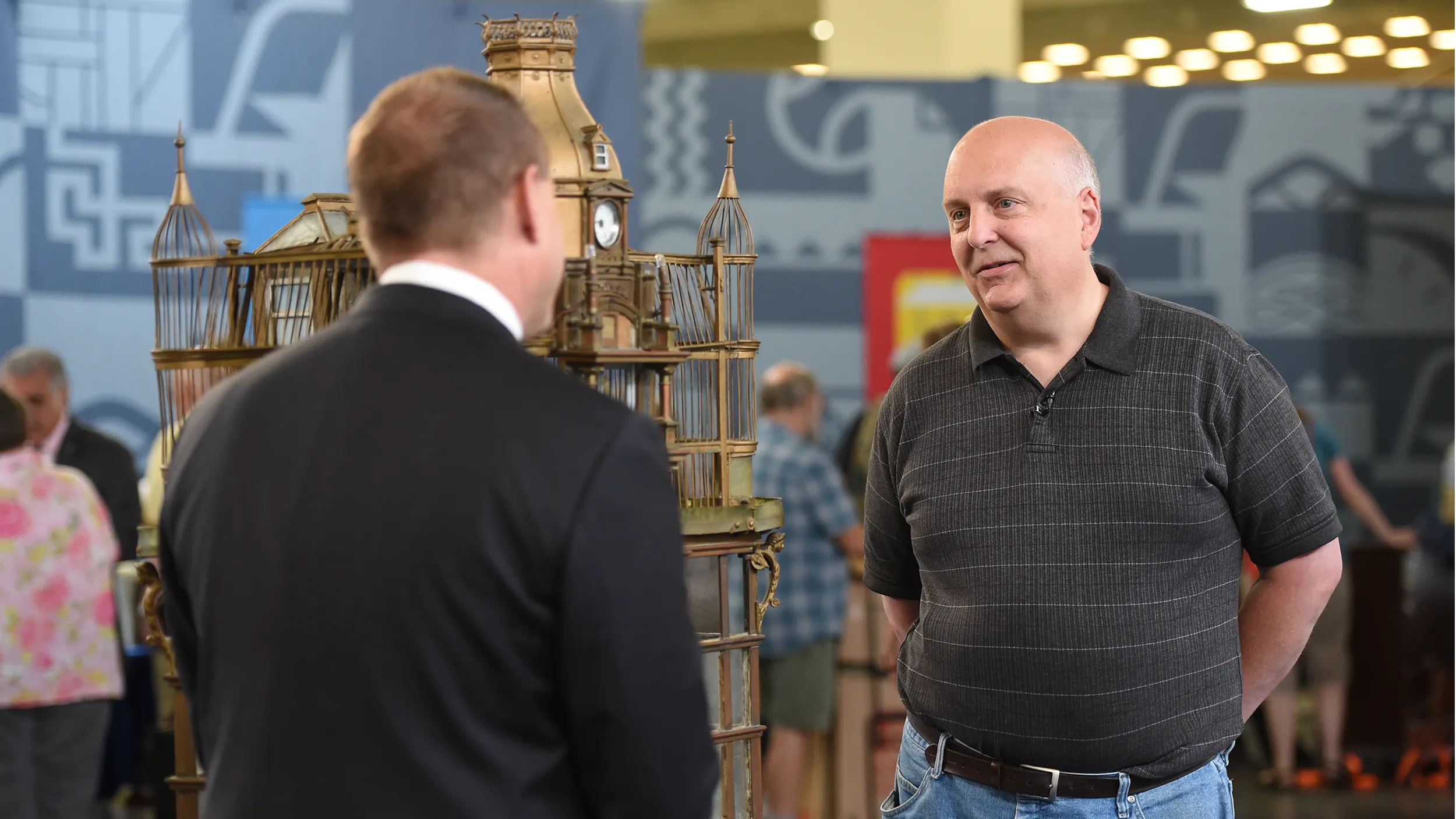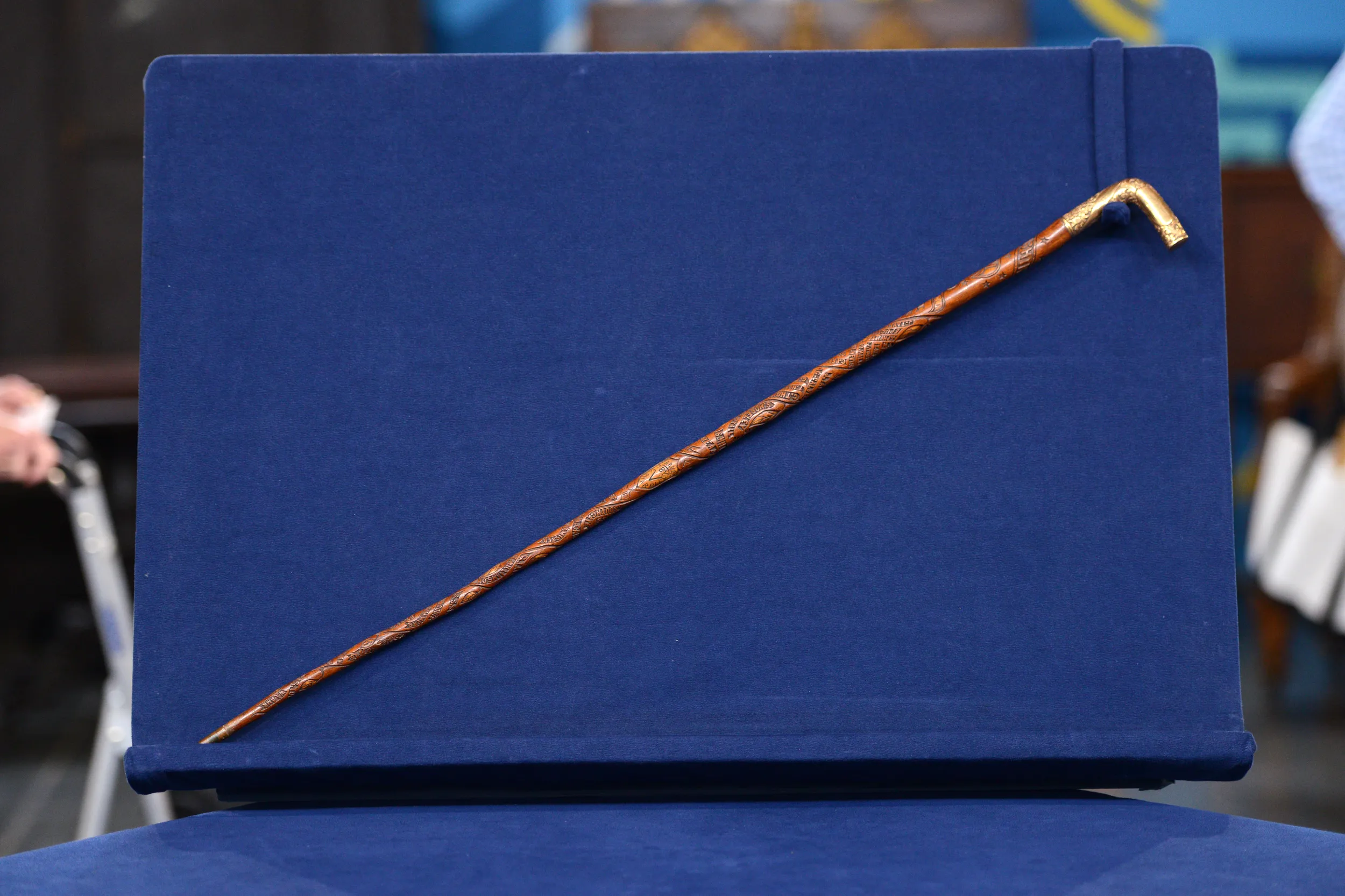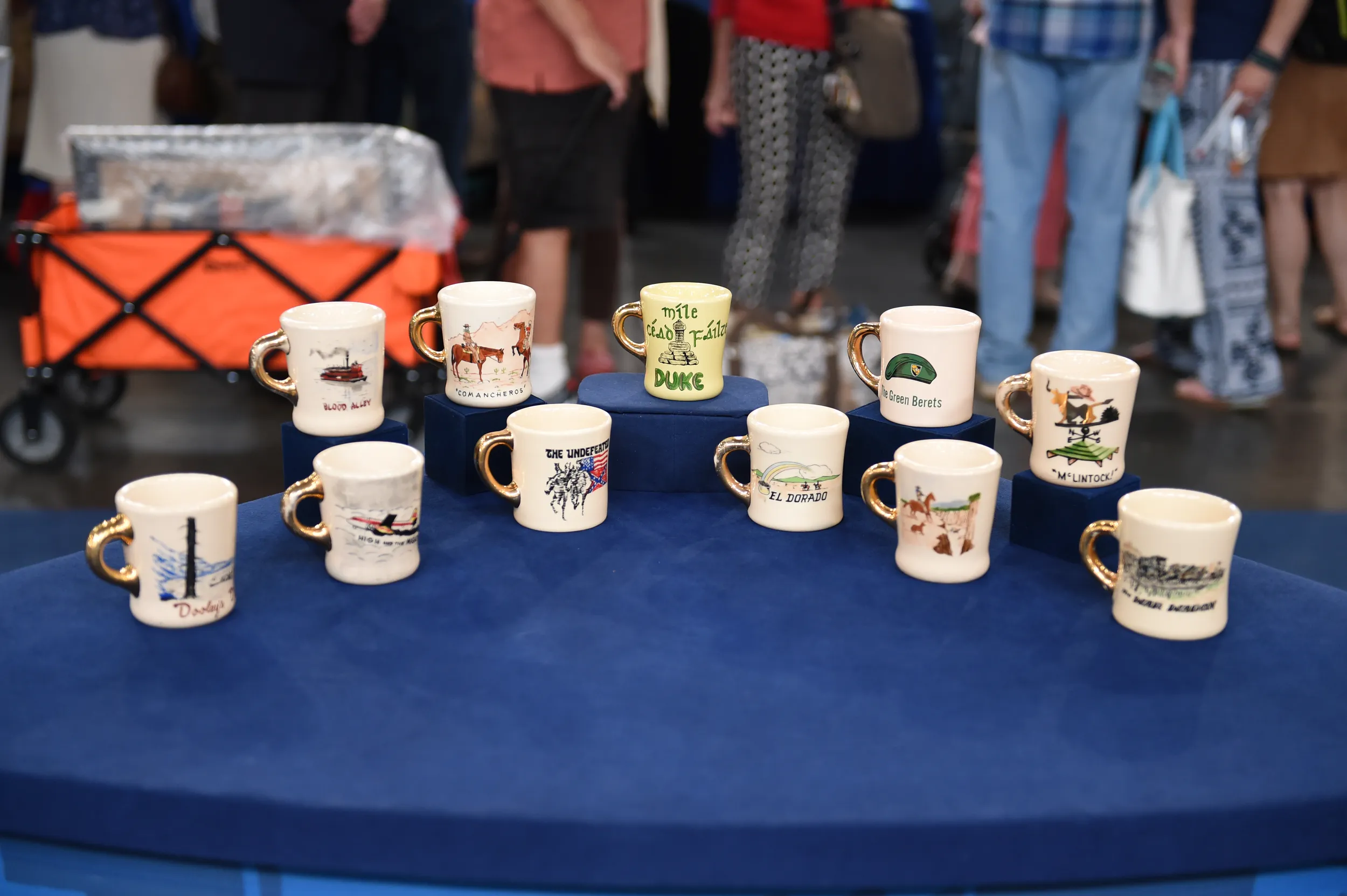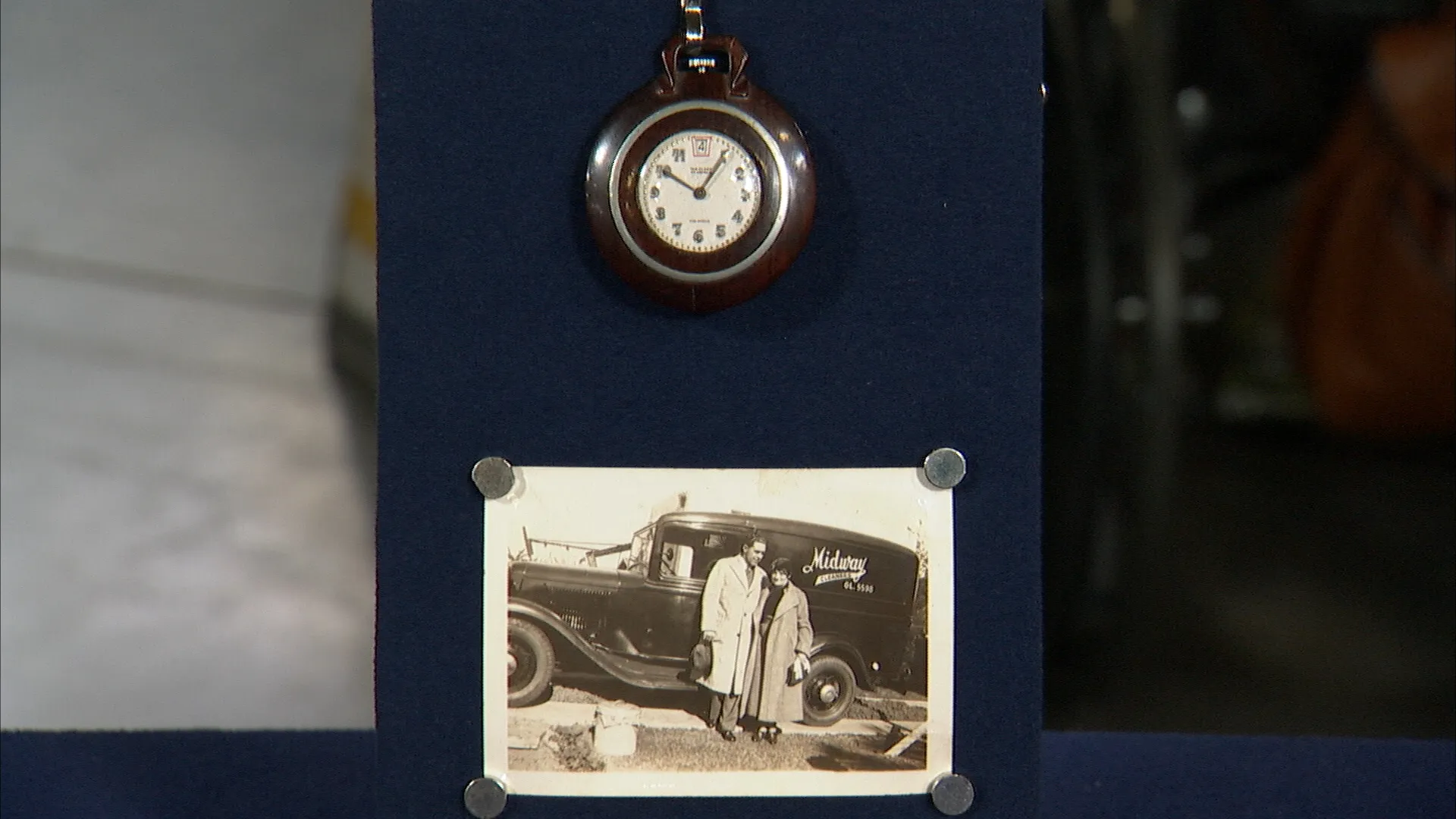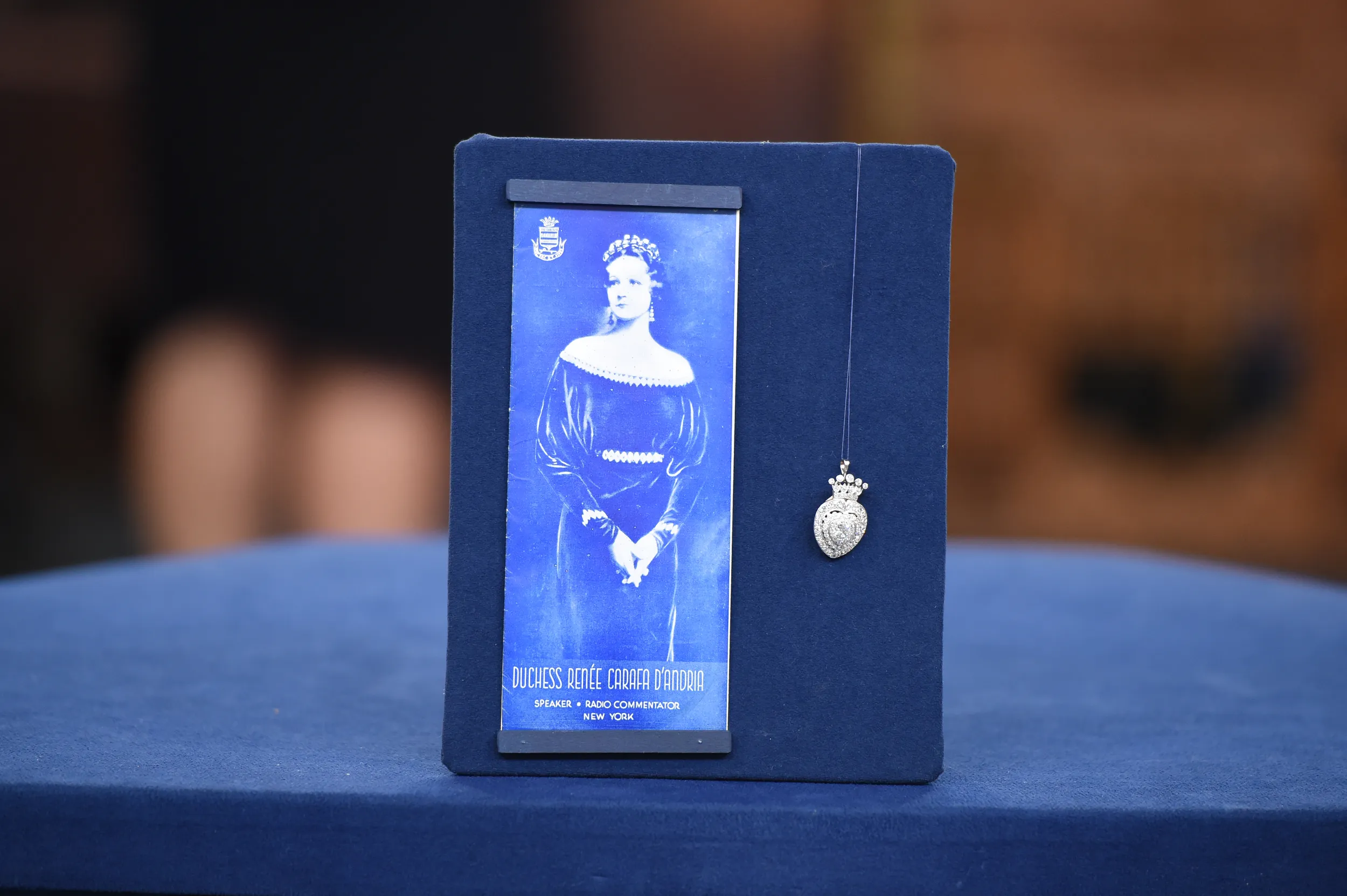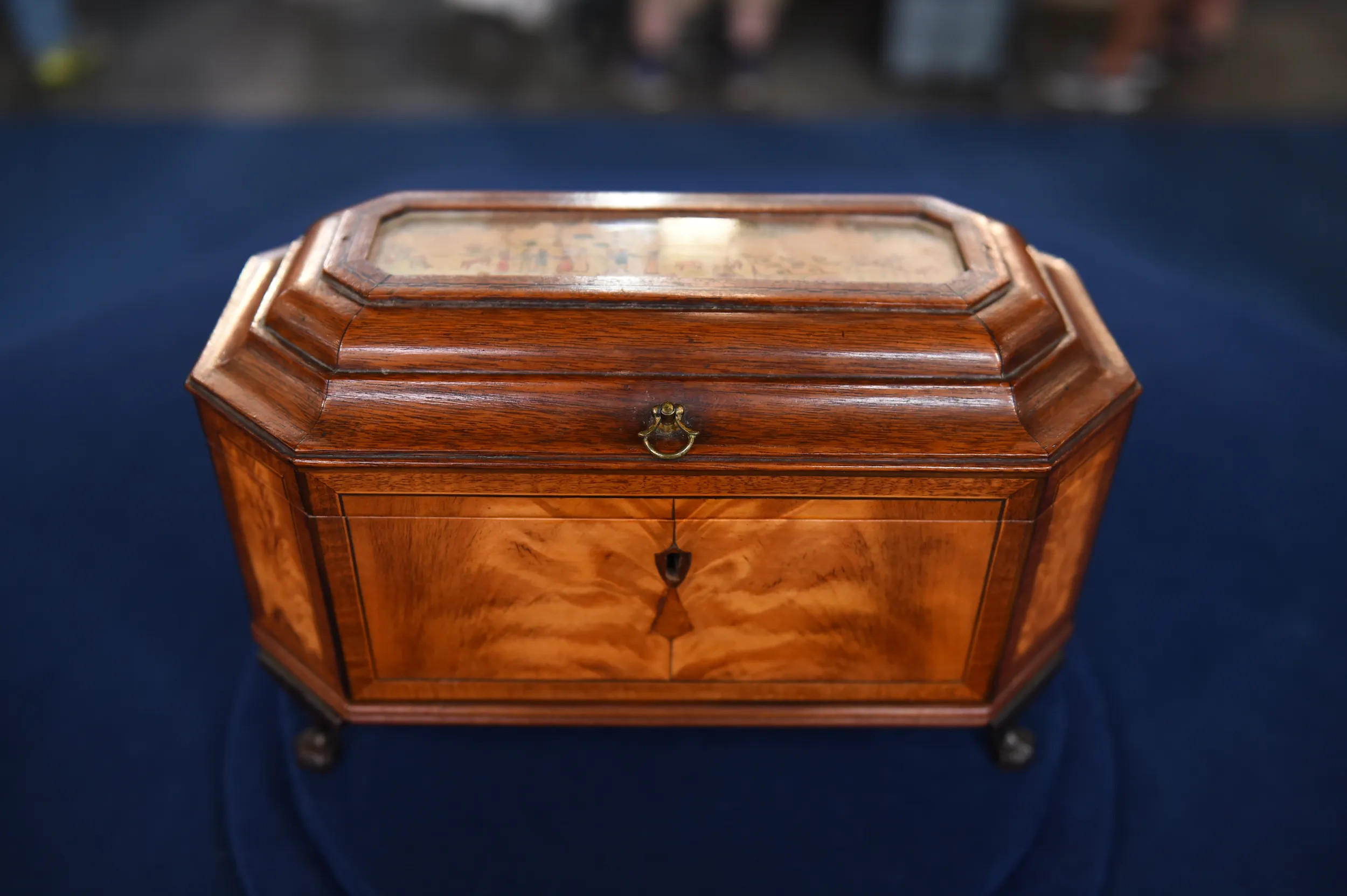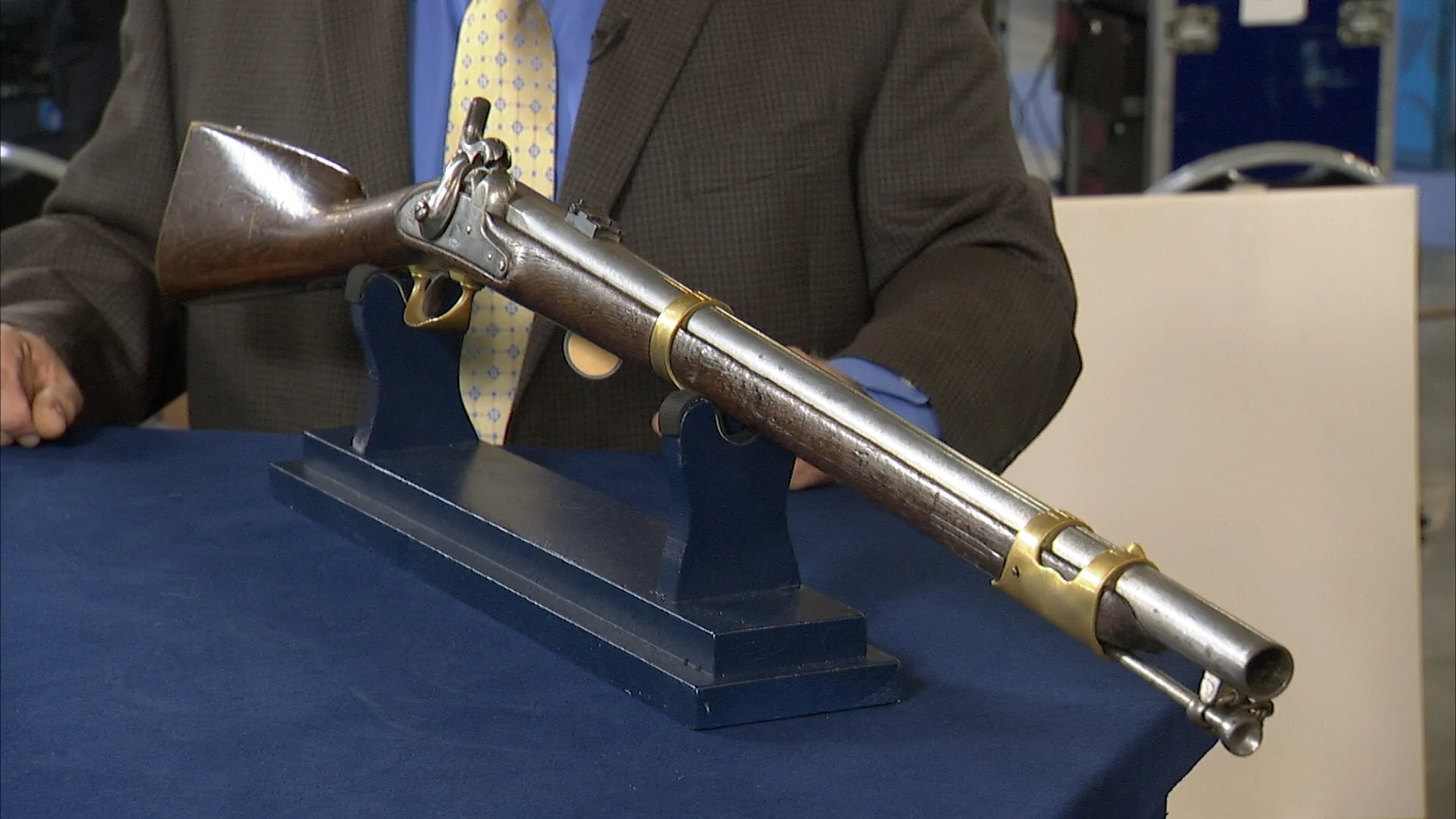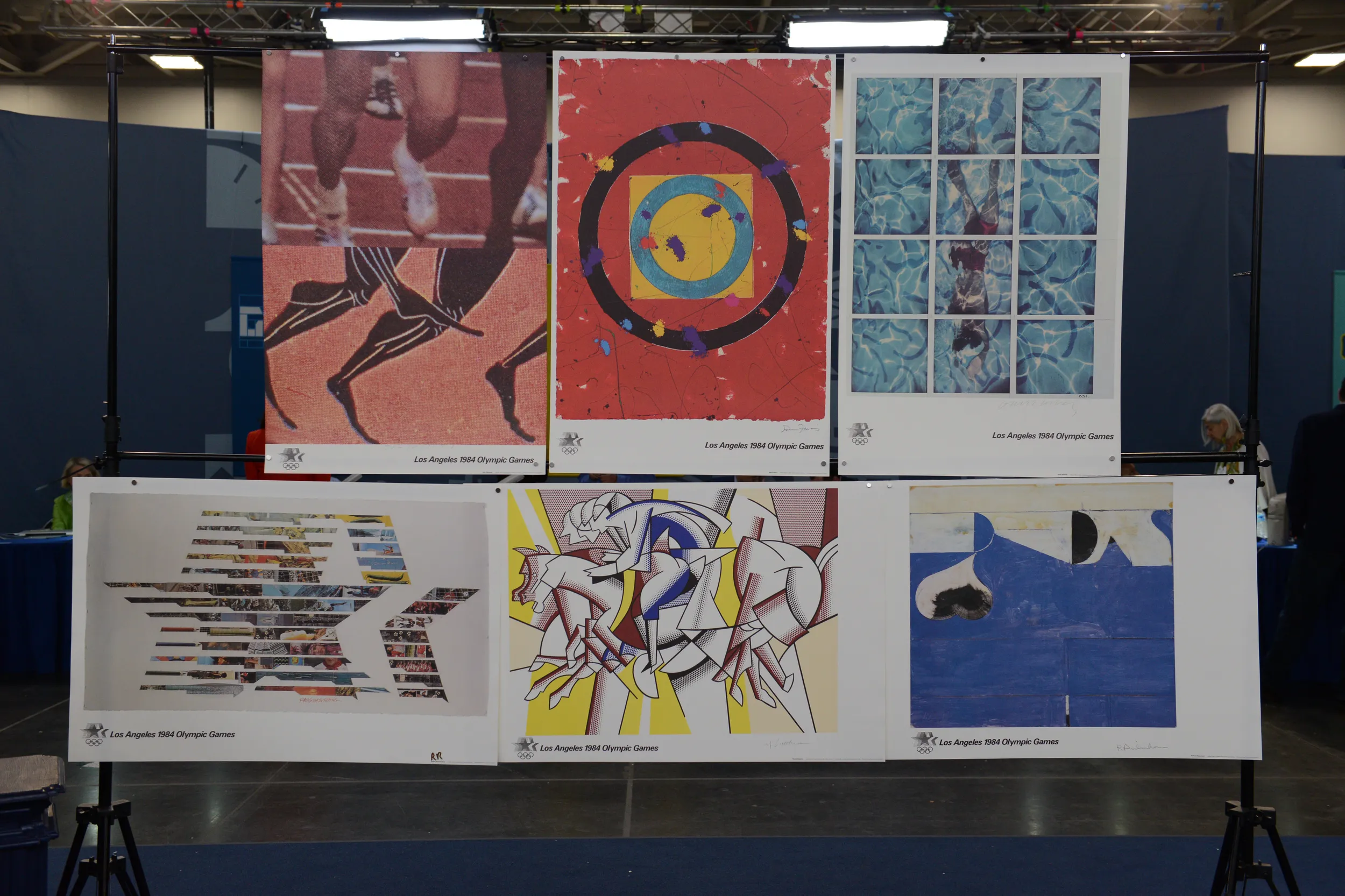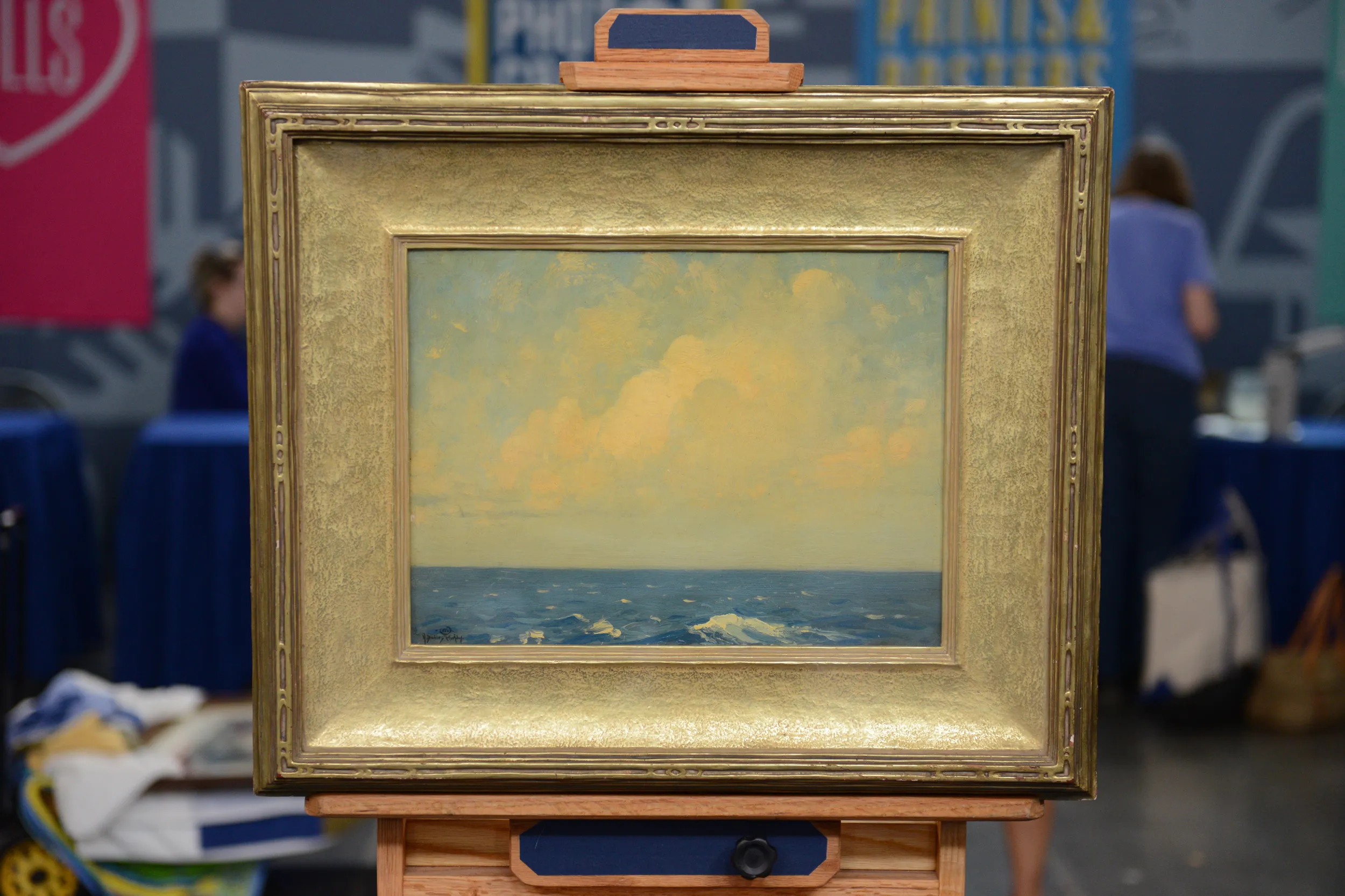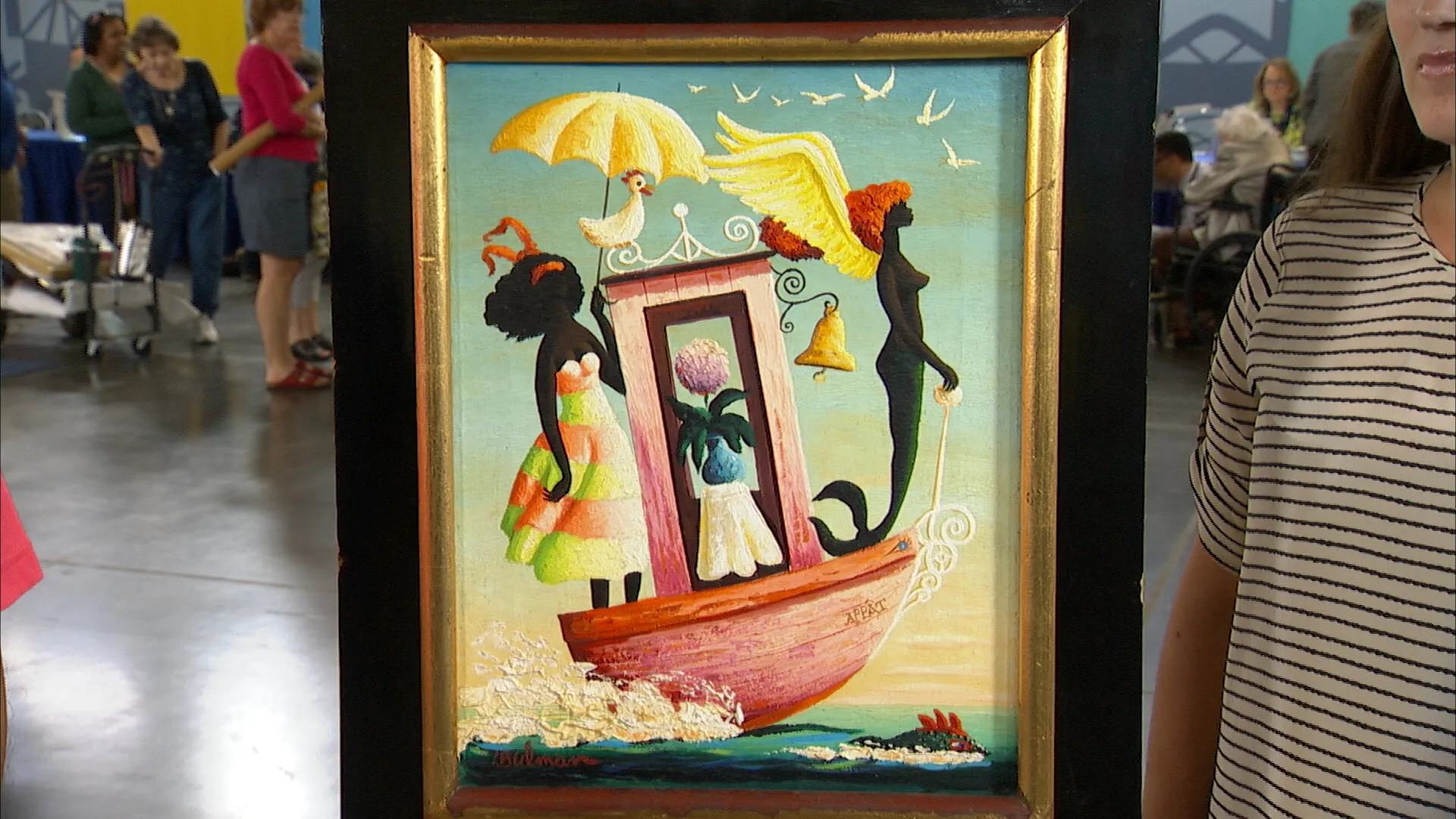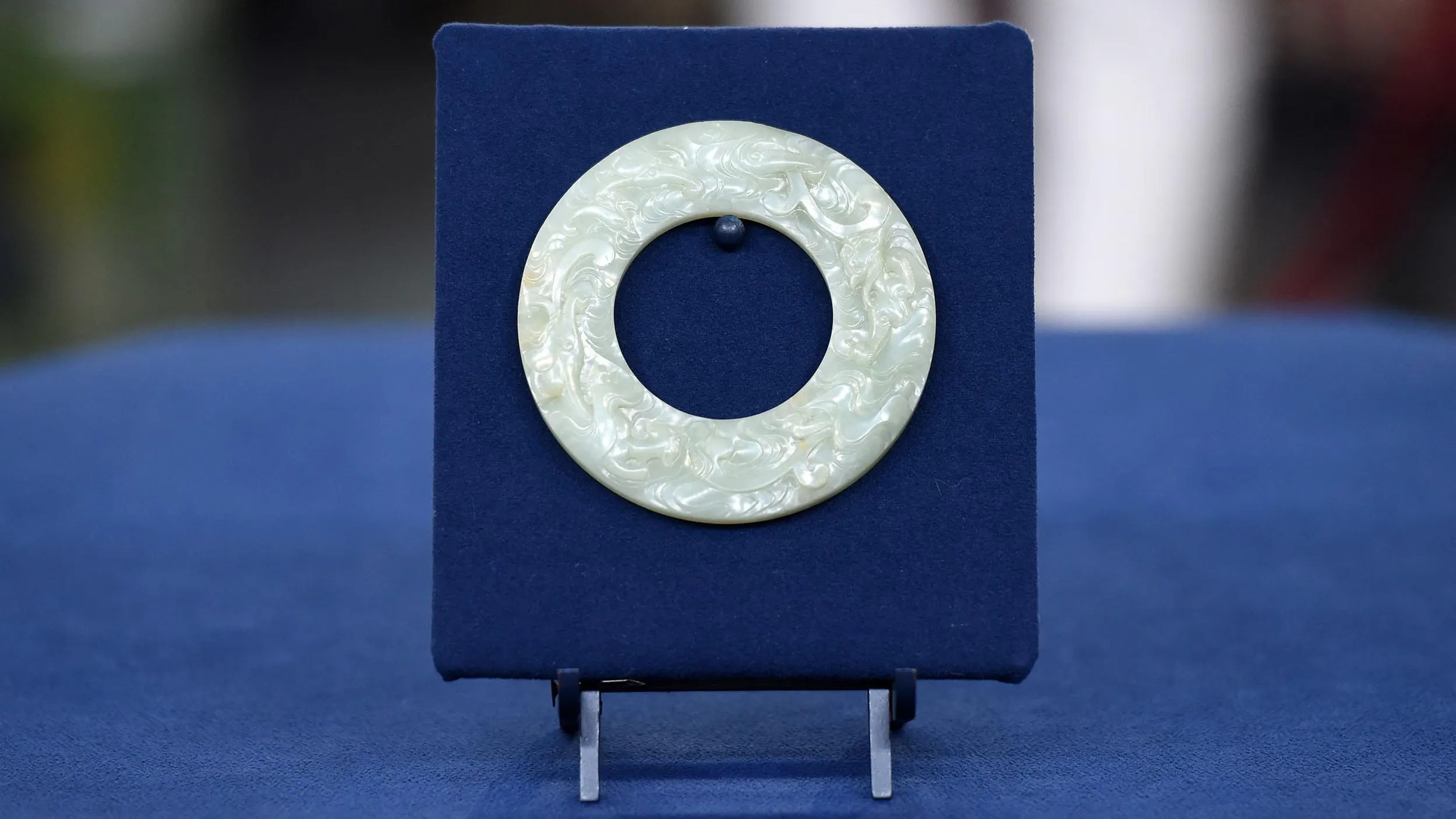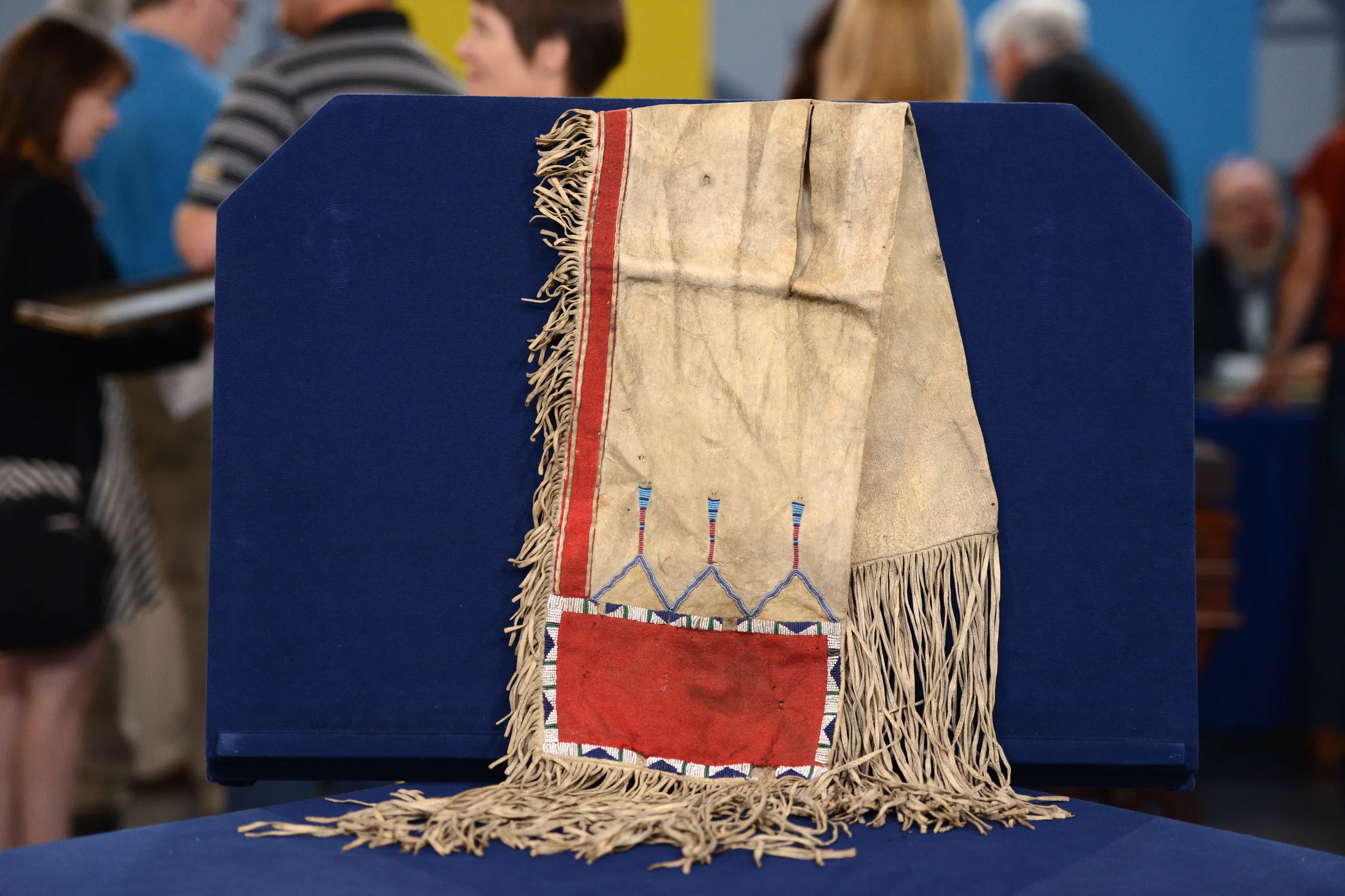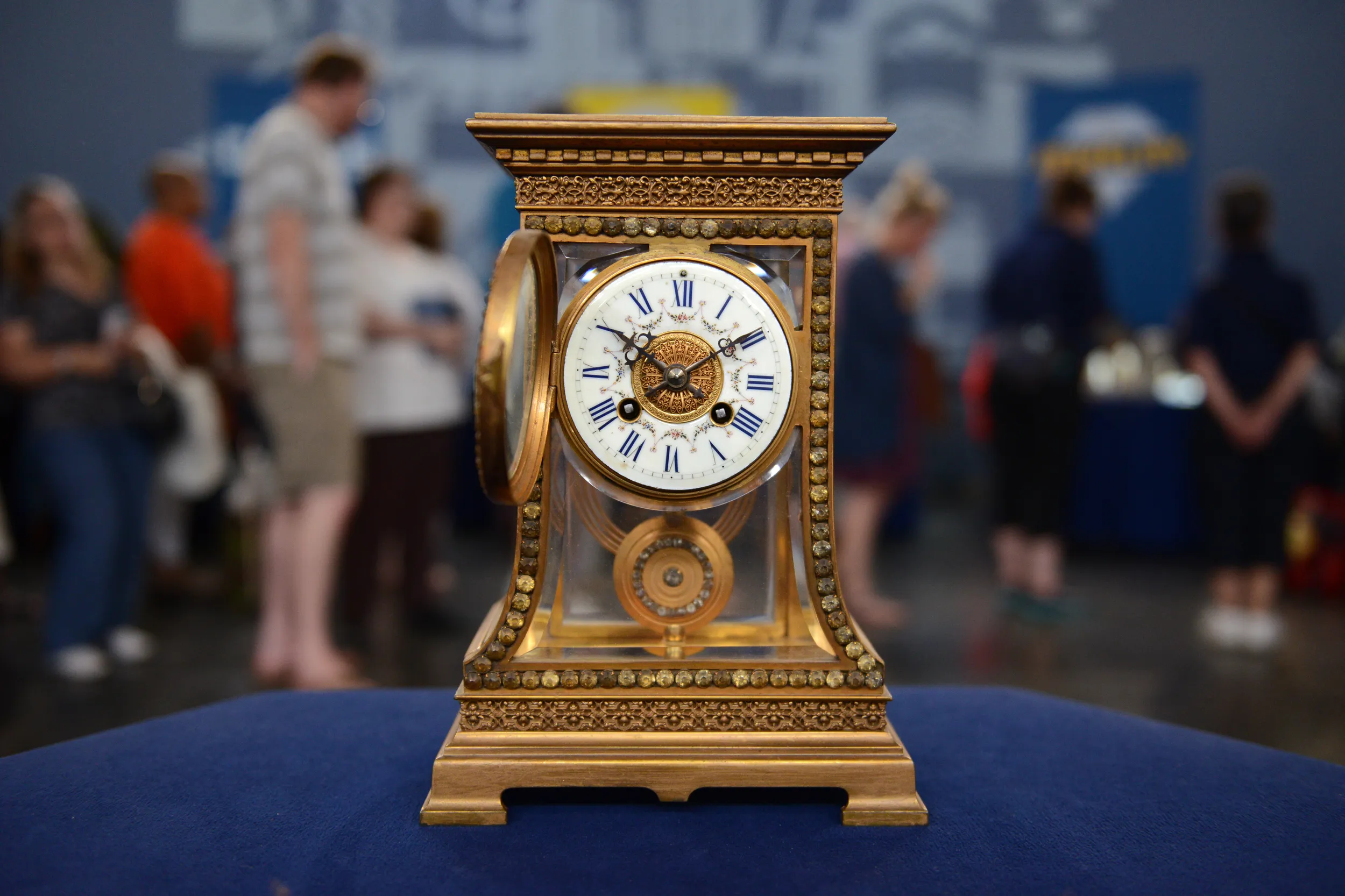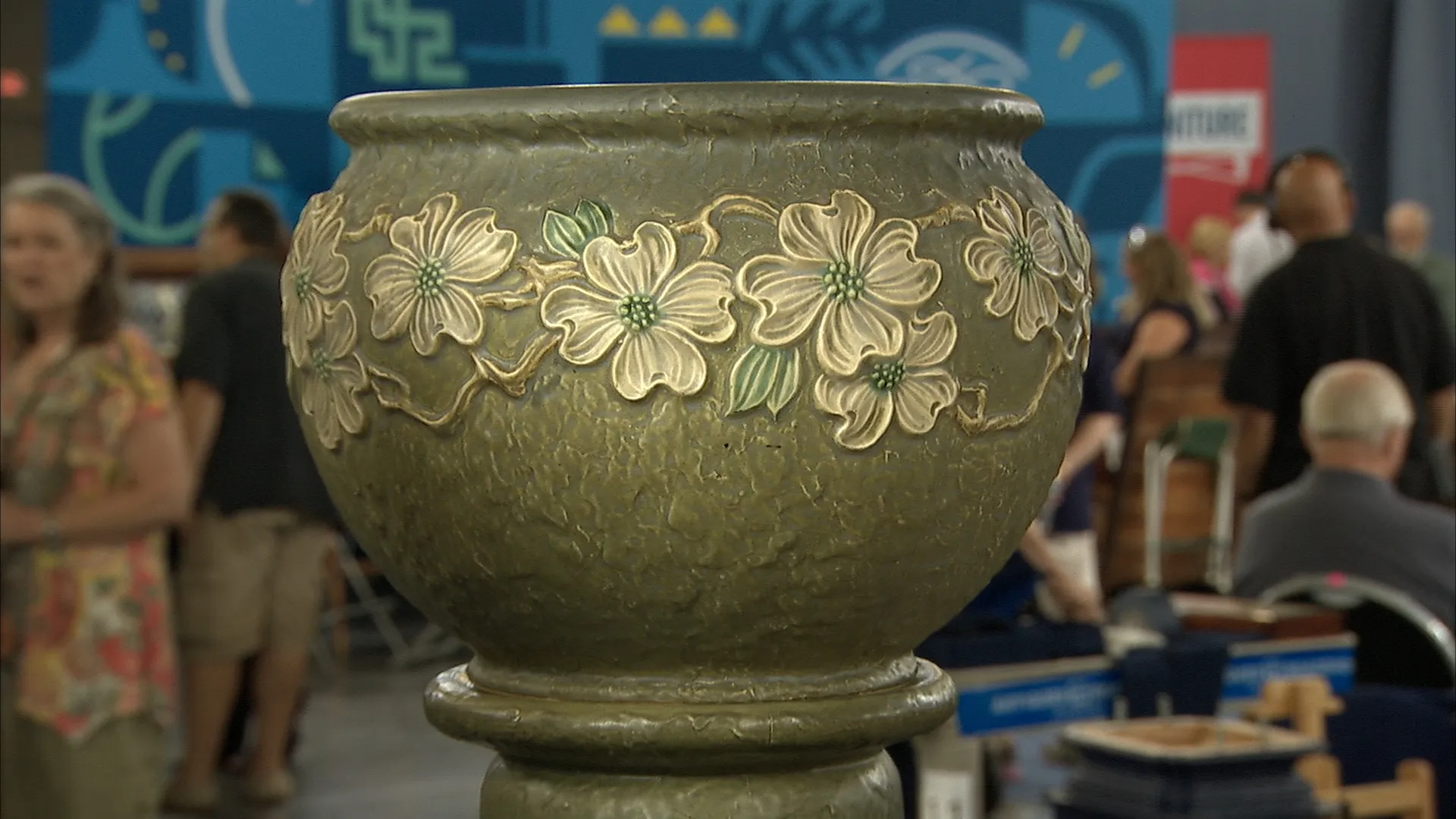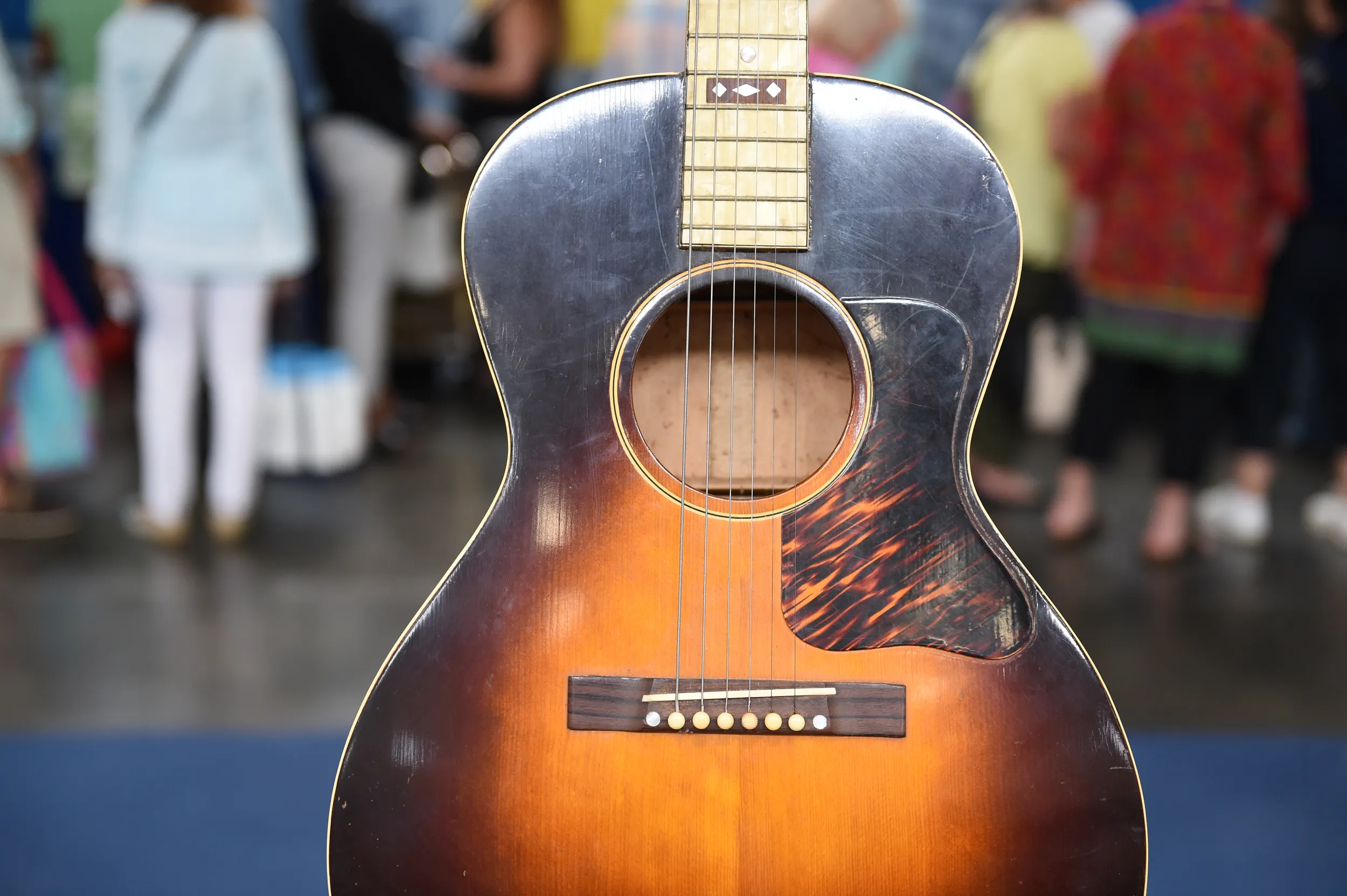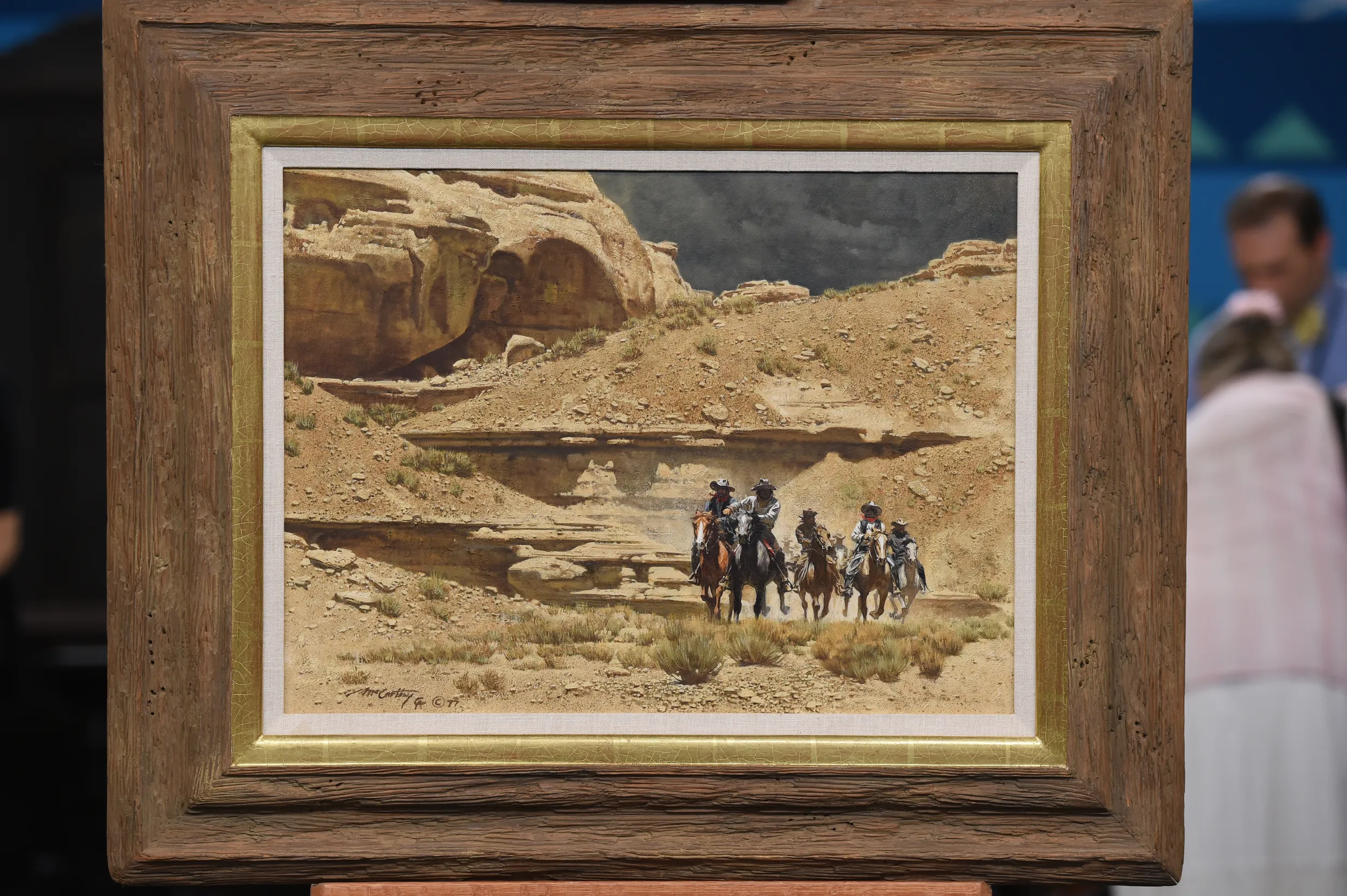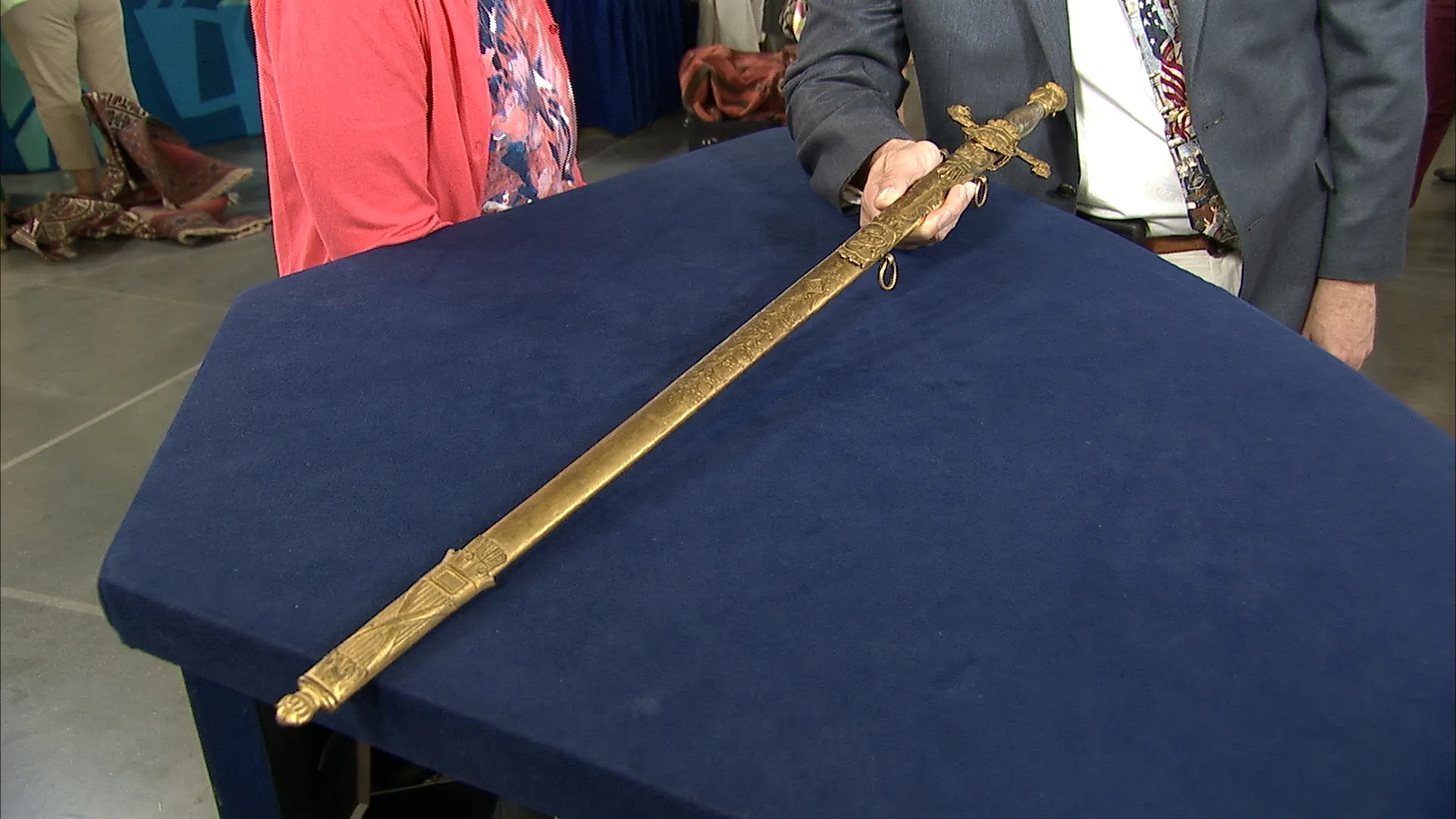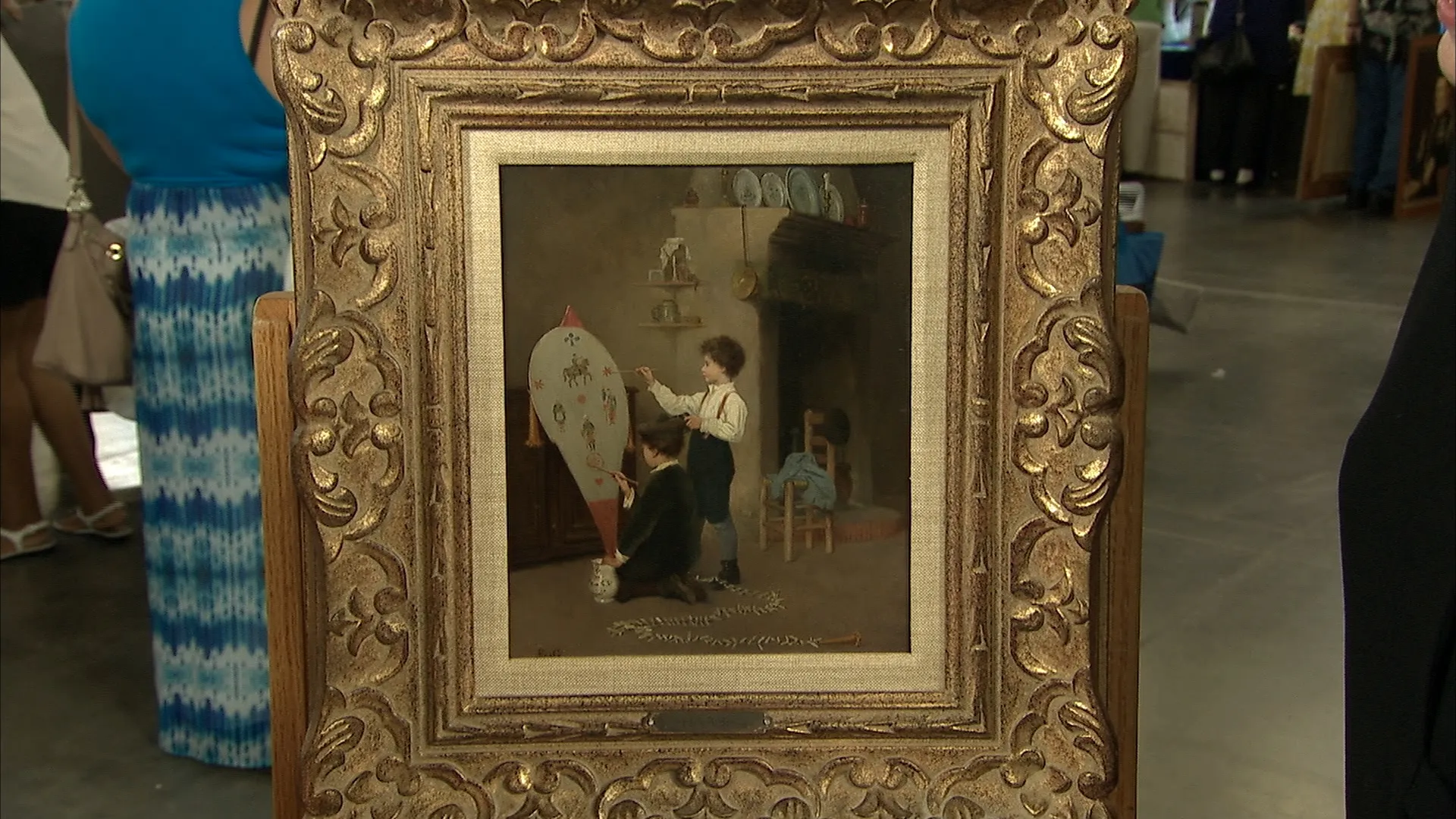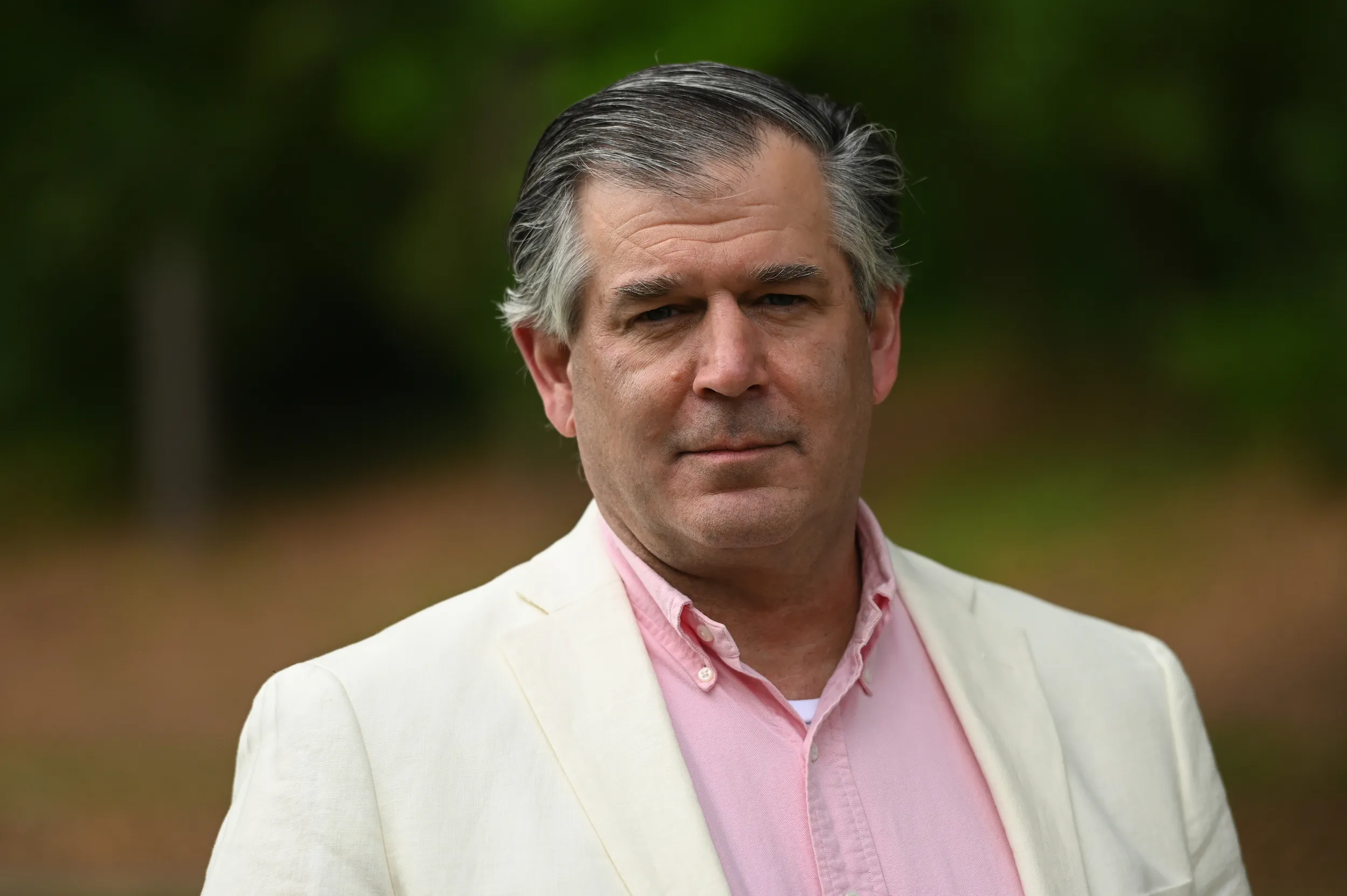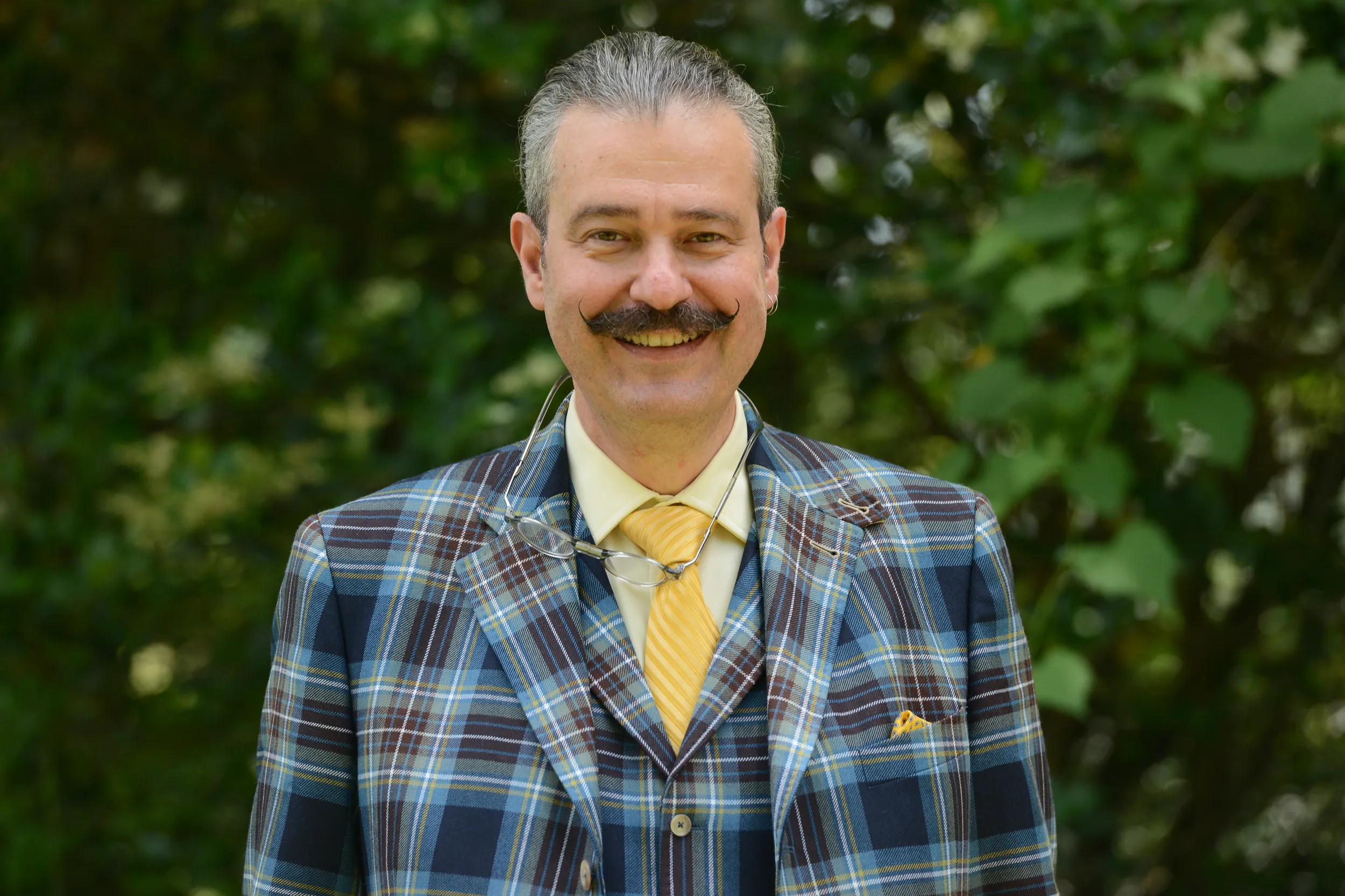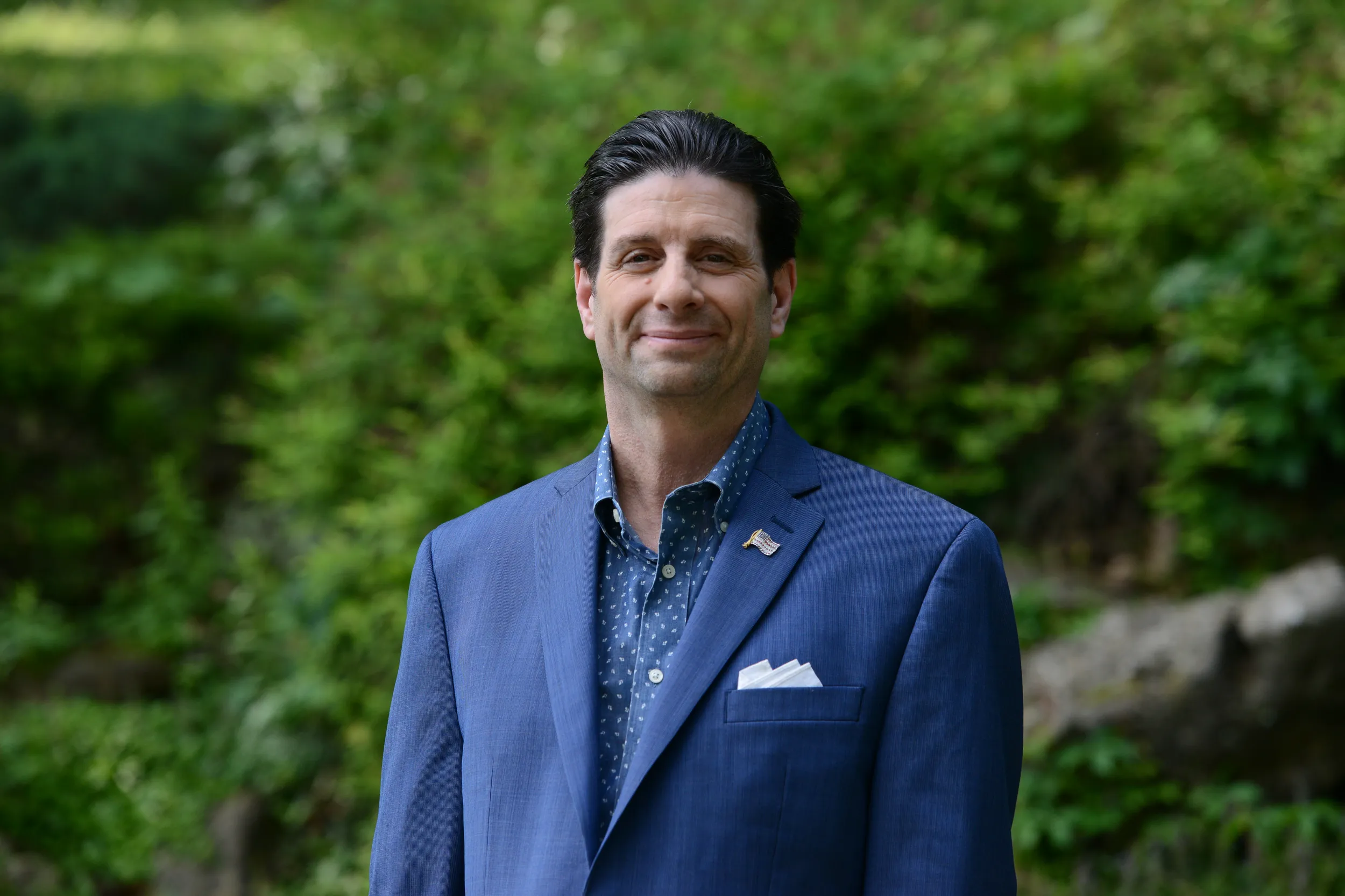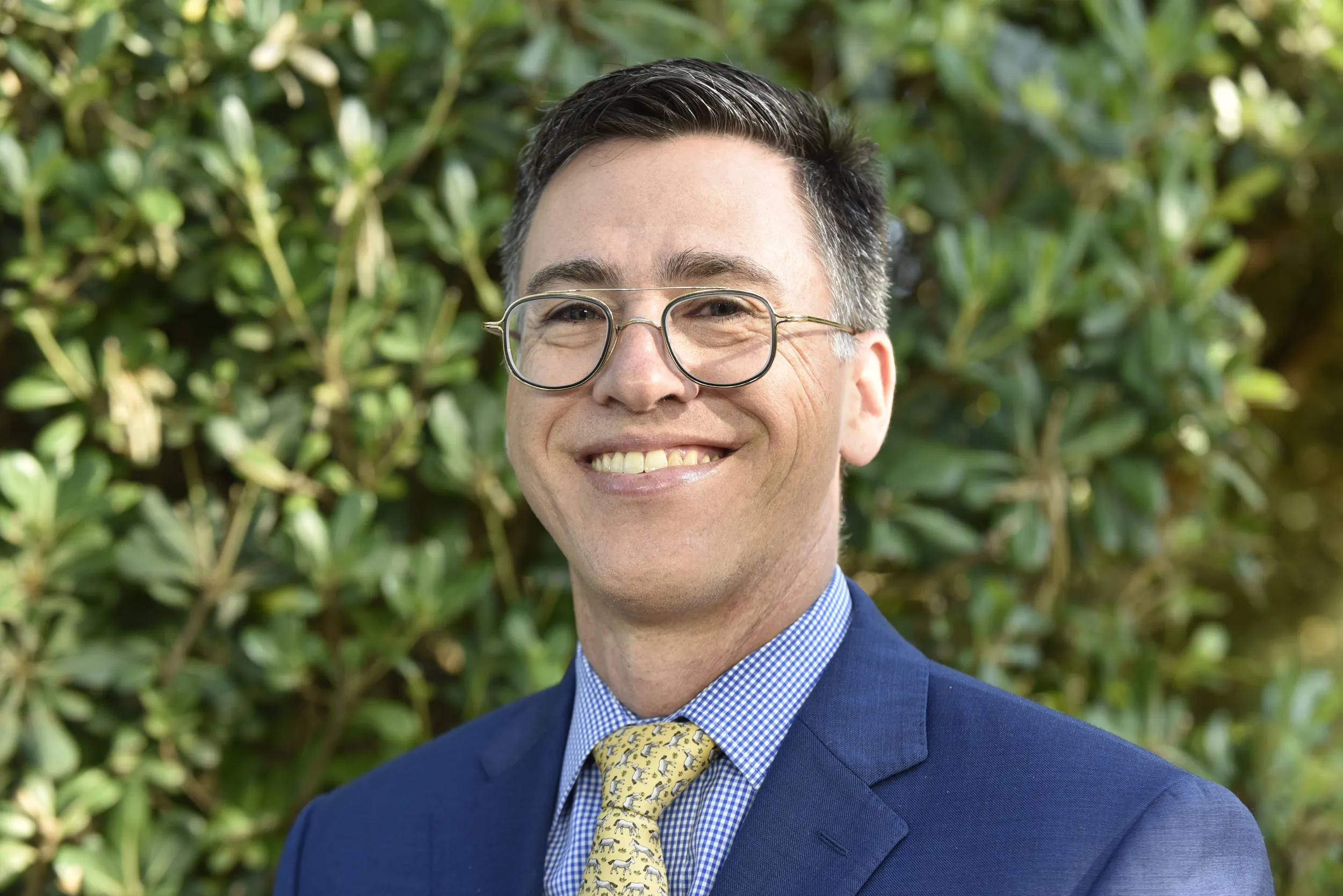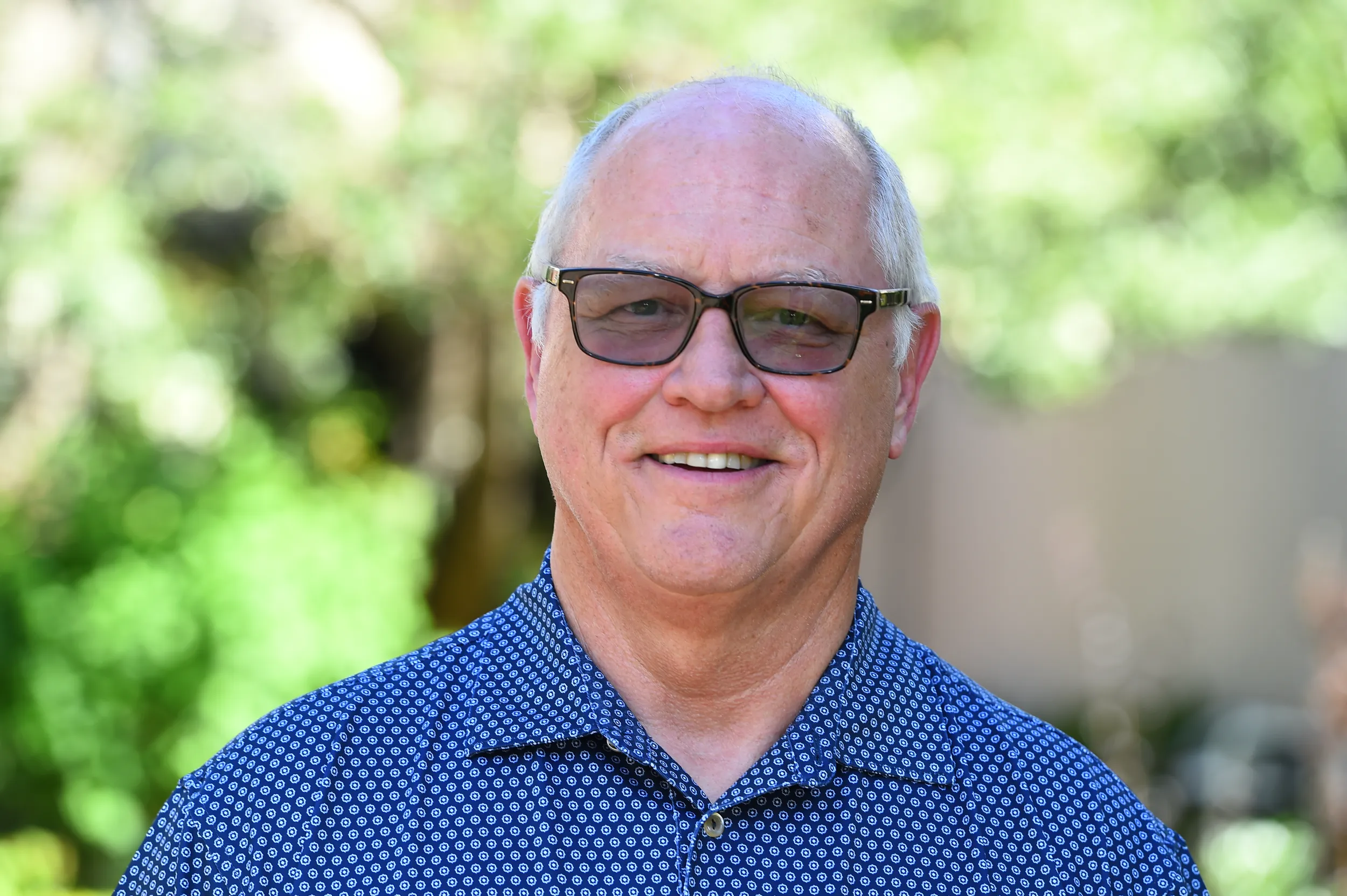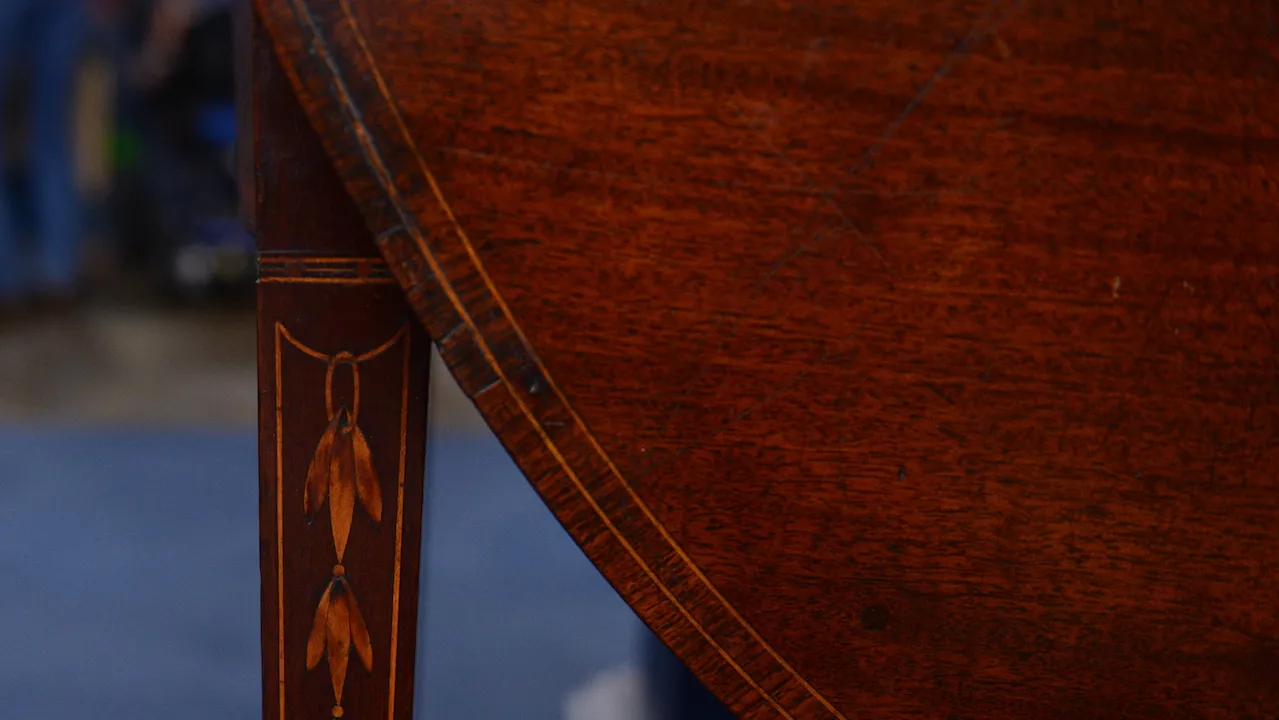HOST: ANTIQUES ROADSHOW is on the lookout for America's treasures in Virginia Beach.
GUEST: My friend told me not to get
emotional.
APPRAISER: Don't cry.
GUEST: (laughing)
GUEST: Ahh, can I hug you?
HOST: It's great to be back in Virginia, famously called the State for Lovers. And this time we've landed in Virginia Beach, where King Neptune, created by sculptor Paul DiPasquale, presides over the sun-kissed residents and beach visitors. Back at the ROADSHOW, antiques and art lovers have gotten together to share their beloved treasures, like this carved cane with local history. Take a look.
GUEST: My great-grandfather was walking, and a house was being demolished. And he noticed a gentleman that was getting ready to break the handle off the cane, and he offered to buy it from him. So it's been in our family for about 80 years. My grandmother gifted it to me about a year and a half, two years ago. So I just brought it to the ROADSHOW, and wanted to get some more info.
APPRAISER: And so you know a little bit about the person who this cane was given to, because it's inscribed here on the handle. It was given to Colonel William Lamb...
GUEST: Right.
APPRAISER: ...mayor of the City of Norfolk, by the police department in
1881. What do you know about Lamb?
GUEST: So my understanding is he was a Civil War colonel. I know his son, I believe, was also Mayor of Norfolk later-- that's about it.
APPRAISER: Well, let's start with the cane, and then we'll get into Lamb. It's a great carved cane. It starts at the top with George Washington, and then spiraling around the total length of the cane are names, including here the name "carved by C.M. Sharpley in 1880."
GUEST: Yeah.
APPRAISER: And the cane handle itself is inscribed as a gift by the police to Lamb. This was given to him shortly after he took office. The thing about Lamb that's interesting is that he's really best known not necessarily because he was the mayor of Norfolk, but he was a colonel in the Confederate Army. Now, in 1861, he was a captain in the Sixth Virginia. When the Virginia troops shifted south, he was promoted to a colonel in the 36th North Carolina.
GUEST: Okay.
APPRAISER: And he was made commander of a coastal fort called Fort Fisher. And he held onto this fort in spite of repeated Union attacks until 1865, when the fort was overrun, and he was severely wounded. And after the war, he came back. Now, the interesting thing about Lamb was that not his son was mayor, but his father and grandfather had been mayor. And what I love about this is that we start at the top with all the mayors' names carved around the cane with tobacco leaves, which are fabulous, sort of a symbol of Norfolk. But if you look at the stick-- and I'm going to have to turn it this way-- at the very bottom is William Lamb's name. And I don't know if you looked before, but there are two other Lambs that are carved in this area. So his father's name and his grandfather's name is carved there. The handle is rolled gold, so it's really brass with a thin gold plate. It's not gold. And one little tip that I can show you, this is called the ferrule, F-E-R-R-U-L-E. And if you're a cane collector, you know that the longer the ferrule, the earlier the cane. So this is a relatively short ferrule.
Now, why do I say that? The early streets were not paved with macadam, which is crushed limestone. They were just... it was mud. And so you had to have a long ferrule to protect your cane. So by the time this cane was made, the streets were at least paved with macadam.
It's a great cane. It crosscuts three categories-- folk art, local politics, and the Civil War. If this cane came up for auction, I wouldn't be surprised if it sold for between $3,000 and $4,000.
GUEST: Really?
APPRAISER: Yeah.
GUEST: That's fantastic.
APPRAISER: For insurance purposes, I would insure it, maybe, for $4,000 or $5,000.
GUEST: Okay, got you.
GUEST: My father was an associate of John Wayne's way back in the early '40s, where he probably met him at an illegal after-hours nightclub on the Sunset Strip. And my dad was a hustler. He'd been born in San Francisco after the earthquake, and he was a bartender, then decided to get into show business. He was in vaudeville. And he was a good guy. And John Wayne was even a great guy. So John Wayne had him as his kind of right-hand man for a long time. And all these movie mugs that you see here, my dad made with John Wayne. When you made a movie with the Duke, after the movie, every cast and crew member got an individualized mug with the person's name on it and generally a picture from one of the scenes of the movies. The only exception was The Quiet Man, where there's nothing on the back, and just something from the front.
APPRAISER: It is very rare that these come up on the secondary market, because they're so personal to people. John Wayne, originally named Marion Morrison, died at the age of 72, but left a legacy far greater than his years. In the '50s, he started his own production company, Batjac.
GUEST: Right. My dad was there, and I visited their offices in West Hollywood many times. It was a fun and family affair, because he had his brother and his sons working there at the same time. And it was really a well-run organization. But the Duke never made much money from that. He just cared about making movies, and was not interested in making the big bang buck.
APPRAISER: So the time frame for these mugs are the early '50s until the late '60s.
GUEST: Yes.
APPRAISER: Most of them were hand-painted, and then, as we spin it around, we can see when they've been dedicated.
GUEST: Yes.
APPRAISER: And so these were dedicated to your dad, and his name was?
GUEST: Well, his screen name was Al Murphy. So some of them say, "To Al from Duke," or "To Murph from Duke."
APPRAISER: So there can't be anything that has better provenance than coming directly from John Wayne. These come up for auction every now and then. There was a big estate sale of the estate of John Wayne in 2011 that broke a lot of records on these. Without the connection to these movies, Wallace Company made $20 mugs, tops. I love this one especially, from The Quiet Man, which... as you said, it doesn't have a direct reference to the movie. It just says, "100,000 welcomes" in Gaelic, which is just wonderful. And it's also in green. That's the only mug that was a separate color besides the cream colors.
GUEST: Right.
APPRAISER: Do you have any idea of what they're worth?
GUEST: I've seen some go for the lesser movies for maybe $1,000, $1,200, and some go for over $2,000. So I think it depends on the movie.
APPRAISER: Absolutely it depends on the movie. We sold the Green Berets one for almost $6,000.
GUEST: Wow.
APPRAISER: And The Comancheros for $4,000.
GUEST: Oh.
APPRAISER: So altogether I would put an estimate on these of $25,000 to $35,000.
GUEST: Oh, my goodness.
APPRAISER: And they could even bring more.
APPRAISER: Generally whatever a rug dealer tells you about age, take 20 years off.
APPRAISER: You know that this is from the mid-20th century, so 1940s, 1950s. Probably somebody was on the Grand Tour, and brought it back to upstate New York, and that's probably how it got here to the States. The very fact that it's a copy, probably looking at about $400 or $500 for it.
APPRAISER: It's great-- it's 18-karat yellow gold.
GUEST: Oh, cool.
APPRAISER: I mean, everybody loves birds.
GUEST: Yeah.
APPRAISER: Did you know it was Cartier?
GUEST: Oh, no!
GUEST: I brought a pocket watch-- it's wood and metal-- from Van Cleef & Arpels. I got it from my Great-Uncle Barney. And he and my Great-Aunt Tiny had a dry cleaning store in Beverly Hills, Hollywood, back in the 1930s and '40s. And they had several famous people as customers. One of them happened to be Josef von Sternberg, who was the director for most all of Marlene Dietrich's films. And so he went over to Europe on vacation one year, and came back with this pocket watch, which he gave to Uncle Barney. They did such a great job in their dry cleaning establishment that he was very appreciative and wanted to show them that, so...
APPRAISER: This is really a great piece. The maker, Van Cleef & Arpels, was synonymous with Hollywood, with Hollywood jewels, with movie stars.
GUEST: I didn't know that.
APPRAISER: Van Cleef was a French company. They were represented here in the States. Their quality is phenomenal. Everything they made had a lot of thought and a lot of design. So this was done around the Art Deco period, early '30s, right around the age when Van Cleef was at its height. It's a manual-wind jeweled Swiss movement. In this configuration, as a man's pocket watch, I've never seen one. They're usually a ladies'... what we call a purse watch-- little mini watches that open and close that were for women. This was made for a man, and to see something like this in wood… well, they didn't survive very well. Retail on this watch would be about $4,000.
GUEST: Oh, okay, awesome, awesome. That's very nice, yeah.
GUEST: I grew up in the state of Kansas, in a little farming community west of Dodge City. And this particular painting always hung in the living room of my mother- and father-in-law's home, over the television. And I always liked it, thought it was a beautiful painting. In my father-in-law's later life, he says, "Gary, would you like to have that painting?" And I said, "Of course." And so that's how I acquired it. And at that time, he was not able to recall all the details of how he acquired it. So I don't know much about how all that happened.
APPRAISER: And who's the painting by?
GUEST: It's by Frank McCarthy. He's one of the Western artists, or cowboy artists. I've researched him some on the internet. He was very prolific, you know, during his career. So I was hoping that you could tell me more than I know.
APPRAISER: Sure, sure.
GUEST: The title of this painting is “On the Owl Hoot Trail.” And an owl hoot trail was the trail that the outlaws used to go into their hideout. And so there's always been a question in my mind as whether these are the outlaws going home, or the sheriffs coming after them.
APPRAISER: Well, I hope to answer some questions. I'm not going to be able to tell you whether or not those are the good guys or the bad guys.
GUEST: Okay.
APPRAISER: Frank McCarthy, as you said, is known for his Western material, but he didn't start doing that. He really started as an illustrator. And he started in New York, and then ended up out in the West, much like Frederic Remington, right? He had a very rigorous training, and he did a lot of illustration work, a lot of book covers. He did a bunch of James Bond covers, if you can imagine.
GUEST: Really?
APPRAISER: Yeah. And then one of our security staff was talking to me earlier-- he also did a lot of Louis L'Amour book covers.
GUEST: Oh, yeah, my father used to read those books all the time.
APPRAISER: That was his start to the West, was those illustrations for Western book covers. But the big moment for McCarthy was in 1973. He had a show in Arizona, the story goes, of 23 paintings, and he sold them all in 20 minutes. So he did what you or I would do, and in 1974 he moved to Arizona, where he painted for the rest of his career. This particular picture, you'll see down here, is signed, McCarthy, and then "CA", that's "cowboy artist," and then the C with the circle, and then "77" So it's after he's moved to Arizona. Right now, at auction in 2016, I think a conservative auction estimate would be on the order of $20,000 to $40,000.
GUEST: For this painting? Wow. Well, I don't know how much it was acquired for, but that's... that's a big number.
GUEST: This piece was originally an engagement ring of my great-aunt. Her name was Renee Thornton. She was actually a coloratura soprano at the Metropolitan Opera in the 1920s.
APPRAISER: In the '20s, okay.
GUEST: Right. After that, she divorced her husband, who was a conductor of the Met, and she ended up marrying, in the '30s, early '30s, a duke from Italy. And she was the Duchess d'Andria. And this was her engagement ring. My mother inherited it, and she didn't like it as an engagement ring, so she changed the back of it, and changed it from a ring to a pendant that my mom could wear.
APPRAISER: Okay. It's a very beautiful piece.
GUEST: Thank you very much.
APPRAISER: I think it's from around the turn of the century, and I think that because it is topped in platinum and backed in 14-karat yellow gold.
GUEST: Wow.
APPRAISER: You can see the platinum running along the top, and the yellow gold along the bottom. If it were earlier, it would be silver-topped yellow gold.
GUEST: Okay.
APPRAISER: The diamonds around... so you have a great group of diamonds. These are all mostly old European cuts. That center diamond is about a carat 17, and this is by calculation, so I'm measuring and figuring out what I think it is.
GUEST: Okay.
APPRAISER: But the whole brooch, excluding the center, you have about four and a half carats of diamonds.
GUEST: Wow.
APPRAISER: Okay, now, I do see that this bail has been changed, and this pin stem as well. So there could have been marks on the back of the piece, and they've probably been removed with these two additions.
GUEST: With the addition.
APPRAISER: I mean, it must have been an amazing engagement ring.
GUEST: Yeah, can you imagine? Just the size of it. I can't.
APPRAISER: I mean, it's so sweet, the heart, and then obviously the crown up top, referring back to royalty. Knowing the provenance,
the style of the diamonds, their nice color, I think a piece like this, retail, would be $20,000.
GUEST: Are you kidding me? Thank you.
APPRAISER: Of course.
GUEST: This is a tea caddy. It was made by an ancestor of mine six generations back. He made it for his bride-to-be. I believe it was 1810 or around there, because they married in 1810, and the inside has her maiden name, so it would have been...
APPRAISER: Yeah, and I would have placed it there stylistically as well. It's a very high federal piece in terms of style. This flame mahogany here on the front, and the panels on the side, a really nice blonde, highly figured mahogany. And then a darker mahogany for the top. The form is sarcophagus form, which was popular, sort of a neoclassical form that came up through the federal period. It has these wonderful little Chippendale-style carved legs, which you don't often see. These usually... you see them resting on a table, or with a simple bracket foot, but this is sort of icing on the cake. Boston has a rich history in tea, obviously, and it was an expensive commodity. So the size and the artistry of your tea caddy could often sort of indicate level of wealth in a family. Do you know what his business was?
GUEST: I heard somewhere he did furniture, then he also had some positions in the town.
APPRAISER: So we see a lot of homemade pieces. This is a masterpiece in terms of craftsmanship. So this is not just a weekend guy puttering around in his shed putting pieces of wood together. The other great thing that I
like about this is this panel on the top, which was a gift to his Bride-to-be. And then when we look inside here, we can see that she's actually signed it. This is very nicely done, pen and ink, very accomplished. And this was an opportunity for women to show their skill in craftsmanship and penmanship, needlework, things like that. The image on the top is... it's so sweet and so naive and sort of... it does contrast stylistically, but that's sort of the nice aspect of it, sort of this high-low appeal, which I really like. I wonder if this scene here is actually their wedding party.
GUEST: I don't know, it could be. I really don't know anything about the scene.
APPRAISER: It just looks like... almost like a picnic scene, because it's got the fiddler and the table that's set up, and they look like they're in a circle, doing some kind of a dance or something. It's very nice, and it gives a really nice personal touch to the piece. All things wooden have not been doing very well in the market lately, even pieces with really high style like this. I think in today's market, in an auction setting, we'd be looking at in between $3,000 to $5,000.
GUEST: Okay.
APPRAISER: I think if we went back a decade, decade and a half, we'd be looking at two to possibly three times that value. The market has come down, but this has so much appeal going for it, I think it would... I think it would do well in any sale.
GUEST: Great.
GUEST: We have no idea if he's ten years or 50 years old.
APPRAISER: It's not a real early one.
GUEST: Yeah, we thought maybe a backyard project.
GUEST: A picker was looking for some lamps for my office, and she called me one day and she says, "I'm on the way over to your house. We're going straight to your office. I found your lamps.” 26 years ago. Came from an estate sale up in Connecticut.
GUEST: My mother got it from her great-uncle, yes, and gave it to my daughter, who's scared of it. (both women laugh)
APPRAISER: Poor daughter-- scarred her for life.
GUEST: Brought a cavalry carbine, model 1847, that I bought back in late 1960 or early 1970.
APPRAISER: What'd you pay for it?
GUEST: Oh, if I remember, I paid $225 for it.
APPRAISER: Okay. Well, you're right, it's a Springfield cavalry carbine. It's a model 1847. They made these guns from about 1848 to about 1859, and this for a long time was our standard cavalry weapon. It's a muzzle-loading gun, percussion ignition. They used them for a little while. They didn't work out so well. And about 1855, we adopted rifled arms for all of our military. This had been smooth bore, so they started experimenting with rifling them and trying to make them better, more effective guns. This is one of those guns. They only did a few hundred of these. Almost all of them got altered for some other use. They didn't get altered to rifle carbines. When they rifled it, they not only put the rifling into the barrel, they put a rear sight on it that's adjustable for long-range use. They also changed over the rammer to one that's hung on a chain. So if you're using it on horseback, you drop your ramrod, you don't lose it.
What's wonderful about this gun is so few of them were done that you never see them complete and correct. One of the things they did when they altered these guns… because when they rifled them, they recoiled more, and it hurt the soldiers. So they drilled out the butt and they put a lead weight in the butt to help reduce recoil. The lead weight over time expands and contracts, the butts always crack. This one didn't crack. It's one of the best examples of these guns I've ever seen. I think a reasonable auction estimate for a gun in this condition that's totally complete and correct like this, somewhere between $6,000 and $8,000.
GUEST: Well, that's a nice return on investment.
APPRAISER: Pretty darn good return.
GUEST: I knew it was worth more than I paid for it, but I didn't know how much.
GUEST: Well, they're 15 different artists that were hired to do... each do a poster for the 1984 Olympics. They did a limited run of 500 each, is what I was told. All are signed. And then they took those and made… mass-produced the rest of the posters.
APPRAISER: That's right. So you have the presentation box with the 15 posters inside. In fact, it was a run of 750, not 500.
GUEST: Okay.
APPRAISER: And of the 750, they were all hand signed by the artists. And these artists really are a who's who of the contemporary art scene. Here we have John Baldessari. Then we have, in the middle, Sam Francis. Closer to you, a collage by David Hockney. Richard Diebenkorn down by your side. In the middle, sort of the great and inimitable Roy Lichtenstein. And then closest to me we have Robert Rauschenberg. Where did you come by this Olympic portfolio?
GUEST: Well, I have a small coin shop in northern Virginia. One of my customers is a big coin collector, and I had a few coins that he wanted.
APPRAISER: And how much did you pay for them?
GUEST: $1,000 value as far as the trade for the coin.
APPRAISER: What really sets these apart from other Olympic posters are
two things. First of all, it's really the first time that an Olympic Games was represented by a portfolio of posters by different artists, as opposed to having one primary designer. And then they really chose some
of the great, great names. The whole portfolio, which is 15 posters, you've done a little research into those?
GUEST: Yeah, it was hard to find something on the total 15 posters. Normally what I'd find is, like, the Lichtenstein, I'd find one, or the Hockney, but I never saw a complete set.
APPRAISER: And we're sort of trained to believe that a collection is worth more than the sum of its parts, right? So if we have the whole collection, it should be worth more than the individual posters.
GUEST: Right.
APPRAISER: Even though there were 750 made in each of these groups, the entire set comes up very infrequently.
GUEST: Okay.
APPRAISER: I found an auction record from 2015, when the entire set of 15 in the presentation portfolio sold for $4,500.
GUEST: Oh, wow.
APPRAISER: But here's the thing-- this portfolio really represents the exception to the rule. And this is one of the rare instances where the individual pieces are actually worth more than the portfolio as a whole.
GUEST: Okay.
APPRAISER: These six posters really represent the greatest artists from the group. At auction, they would sell, alone, for between $5,000 and $7,000.
GUEST: Wow.
APPRAISER: So just these six would sell for more than the portfolio.
GUEST: Wow.
APPRAISER: And I figure the other nine posters that are inside the portfolio would probably sell for a combined $2,000 to $3,000.
GUEST: Okay.
APPRAISER: So by breaking them up, the total is $7,000 to $10,000, which is almost twice what the portfolio as a single unit sells for.
GUEST: Wow. More than I was expecting.
GUEST: When my older sister passed away, my daughter and I came across this painting and another painting, and realized that it was her ex-husband's. And we called him to tell him that we had the painting, and if he would like it back we'd be glad to send it to him. He said, "No, don't worry about it. Just keep the painting-- it's only worth a few thousand dollars."
APPRAISER: Okay.
GUEST: So last night, 12:00 at night, I pull the painting out of the closet to bring it, thinking that the frame must be worth a lot more than the painting.
APPRAISER: Okay. Which it may be. Let's start with the painting. The picture is by a Boston artist, which is why I'm sort of happy to see this. I'm from Boston, so it's lovely to see. It's like seeing an old friend. And it's signed. It's by Hermann Dudley Murphy, and if you look over here, you can see it's signed both in writing, and there's also a funny little monogram up above. It's sort of his cipher. And he would sign many of his works with that.
And when you're training as a painter at the end of the 19th century, it is de rigueur that you have to go and you have to study in Europe. Because that's still where the finest art is at the end of the 19th century. So he went to Paris. He went to the Académie Julian in Paris, which is where a lot of Boston painters went. While he was in Europe, he met up with James McNeill Whistler, who was a rather irascible gentleman, but they became friends nonetheless. And one of the things they had in common was an interest in frames. Framemaking at this point in time in America was sort of a lost art. And so when Murphy came back to the States, back to Boston, he started looking around and realizing there was nobody making great frames. And he didn't want his works going into lesser frames. So he started making his own frames.
GUEST: Wow.
APPRAISER: He got many compliments. Everybody commented on how terrific the frames were, how beautifully made they were, how they complemented the art of the day. By 1903 he had started a frame shop of his own. Within the next couple of years, he had hired Thulin and Charles Prendergast, the brother of the famous painter Maurice Prendergast, and they were making these beautiful frames. Hermann Dudley Murphy was painting throughout the beginning of the 20th century. A picture such as this probably would have been painted right in the 19-ones or the early 19-teens. It is a Hermann Dudley Murphy frame, made for his own picture, so that... the fact that the two are unified makes the whole package more special. And it's a lovely painting, in need of cleaning, but when you're 100 years old, you'll need a bath, too. Right now in its current condition, realistically, just for the painting by itself, you're probably looking $7,000 to $9,000 as an auction estimate. Now, the frame has probably also got a lot of value. Not as much, but it's probably a $2,000 to $3,000 frame. But when you put the package together and present it at auction, realistically at auction, the package would sell for between $10,000 and $15,000.
GUEST: Really?
APPRAISER: Really.
GUEST: Really?
APPRAISER: Really. Don't cry. It's okay to cry.
GUEST: Thank you, Bon.
GUEST: This is Peter Louis Ravené, and this is Edmunde Ravené. And they are my great-great-grandparents. They are French Huguenots. Fled to Germany, ended up in Berlin. He was a huge steel and iron foundry entrepreneur, and was a big fan of the arts, and had a gallery in Berlin, and commissioned Gustav Blaeser to do his statuettes of him and his wife.
APPRAISER: They're wonderful sculptures, and it is really remarkable on the ROADSHOW to have somebody come in with a sculpture of one of their relatives. But what's even more extraordinary is that these did not come down to you through your family-- they came an unusual way. How is that?
GUEST: My uncle and aunt in New York, they're both artists, and my uncle loved to go into the city and look in the art galleries. And he was strolling the art galleries one day and saw in the window the statues and thought they were lovely, and saw the Ravené name, and had to run home and tell my aunt. He said, "You have to come in to see these-- they're your ancestors." So she came in and fell in love with them, and of course had to have them.
APPRAISER: What's extraordinary also is the names are not just incised or engraved on it, but they're actually set in silver.
GUEST: Yes.
APPRAISER: So the silver is inlaid to the bronze.
GUEST: Okay.
APPRAISER: And on her purse here, that's also inlaid with copper and gold. Wonderful portraits. Their costumes are great. And I think it shows the skill of the artist that they really have a wonderful expression-- the way she's in this pensive position, and he's, again, very stalwart and everything, and he has that great bow tie. I mean, it's really, really a wonderful group. Both of them are signed.
GUEST: Yes.
APPRAISER: And dated. Blaeser, and it's dated 1847. Over here we have the foundry, and it's Konarzewski. Most of the sculpture we see at the ROADSHOW is French or American, so it's unusual to see German sculpture, and it's particularly… this is very early for sculpture in 1847. So how much did your uncle pay for these?
GUEST: He paid $10,000 for the pair in 1986.
APPRAISER: That was a hunk of money.
GUEST: Yeah, it was.
APPRAISER: But that was retail Madison Avenue in those days.
GUEST: Right.
APPRAISER: And all things considered, it's a lot of money, but when you think about this artist who did many, many monumental commissions in Germany, you think of the quality of the bronze, the way it's cast, the way it's finished, fantastic patina, the fact that it has this inlay of silver, it's really a reasonable price for objects of this quality. Works by German sculptors of the mid-19th century are not particularly popular. There's no surging demand for sculpture. I would put an insurance value on these for around $25,000.
GUEST: Okay. For the pair?
APPRAISER: For the pair.
GUEST: Right.
APPRAISER: Yeah. Anybody in your family look like these two guys?
GUEST: You know, my father kind of has his nose.
APPRAISER: Tell me about this chair.
GUEST: That's been replaced.
APPRAISER: Okay, where did you get the chair?
GUEST: At an estate sale in Gloucester.
APPRAISER: Okay. And may I ask how much you paid for it?
GUEST: $600.
APPRAISER: Okay. You know, I need to consult with a colleague on this, so give me just one second, okay?
GUEST: Sure.
APPRAISER: A pad foot on a chair like that is a Williamsburg, Virginia, detail. It might be British, but if it's Williamsburg, it's worth a lot of money.
APPRAISER: That chair had things that relate to other known American ones, but the reality is I just didn't have the resources here. I couldn't really nail it, you know? As a British chair, that's an $800 chair. As a Williamsburg, Virginia, chair, it's an $80,000 chair. Hard to let it go, but you've got to be able to get it right.
GUEST: I brought a painting that I got from my grandmother. It was a painting that she acquired from the artist, I believe sometime in the 1950s or '60s.
APPRAISER: Orville Bulman was born in Michigan, and his father was the inventor of the Bulman paper cutter. So in the early 20th century, pretty much any deli or grocery store that had a roll of butcher paper, or anything on a roll that needed to be cut, was on their invention.
GUEST: Oh, my gosh.
APPRAISER: So he was kind of destined to become the person who was going to run the family business. But he had a love for art, and he started painting, and he just couldn't give up on the painting. He was really self-taught. He never studied art in school, didn't go to college for art. He did move to Florida, to the Palm Beach area, in 1946. And that's really where he began showing as an artist and became quite well known. He became very influenced in the 1950s by Haiti and the culture in Haiti and the people of Haiti. And then he started really using that as his subject matter going forward. Have you ever had this appraised before?
GUEST: Never.
APPRAISER: It's a good size painting for him. He painted a lot of small paintings. It's kind of the medium size. There are a few larger ones that we've seen come up for sale. But this size work at auction, if we were going to estimate it, we would estimate at $10,000 to $15,000.
GUEST: Oh, my gosh. Oh, that's remarkable. Oh, that's quite a surprise.
GUEST: This was a gift from my Aunt Juanita. She went to Shanghai in 1929 to teach English at Shanghai University, and they lived in Shanghai until 1957 and then moved to New York City. And I don't know if it's something that she had in China and brought with her, or if it's something she purchased in New York City.
APPRAISER: So one of the first things one notices about this is the shape, the circular shape. And the second thing one notices is the color, which, pale green we refer to as celadon. The other thing to notice about this is the surface is carved with this undulating pattern of clouds or waves populated by several dragons. And there's a dragon right there. And you can see the head a little bit lower. And they're almost impossible to tell, because they're weaving in and out among the clouds or waves. You look at it and you go, “What in the world is this about?" So on the reverse, there's this fine crosshatch pattern that covers the entire surface. And that's really important, because this is a reference to a type of ritual jade object that was included in burials from as early as 3000, 3400 B.C. up through roughly around the Han Dynasty, which was second century A.D. And now one might ask, well, why in the world did they put this in a tomb? It's because this shape, the circular shape called a bi, B-I, has a connotation in Chinese culture of representing the sky. And it was complemented by another form called a cong, spelled C-O-N-G, which is this rectangular vessel that has open ends and represented the earth. So you would include these from an ancient period of time in burials, because it was the connection between our earthly existence and our heavenly existence. But the question then leads us to when?
GUEST: Yes.
APPRAISER: It wasn't done at an ancient period of time, because the ancient period would not have had the dragon and wave and cloud surface.
GUEST: Okay.
APPRAISER: It would have been a different kind of surface. The first time, believe, you would have seen something like this would likely have been in the 18th century. But this is really unusual, so it's not something that we can compare it to. And there was, during the early 20th century, a revival of object styles that were popular during the 18th century, or had references back to earlier Chinese history. So I'm not sure. I'd love to be sure always, but I'm not sure whether this actually is an 18th century bi, or is this an early 20th century version of the same thing? So what I'm going to do in terms of value is use the more conservative figure.
GUEST: Okay.
APPRAISER: As if it dated from the early 20th century. But it's the kind of thing that's going to require more research. You want to venture a guess on what kind of value this would have?
GUEST: Well, before hearing all that, I might have said, like, $400, $500.
APPRAISER: I think a more reasonable amount would be $15,000 to $20,000.
GUEST: Oh, geezy-peasy.
APPRAISER: At auction.
GUEST: Oh, goodness. Wow. My friend told me not to get emotional. Another treasure from Aunt Juanita.
GUEST: This was collected by my great-grandfather. I moved into a home that was built in 1836, and I'm the fifth generation that's lived there. And nobody threw anything out. And the story behind this was my great-grandfather got into a little bit of a situation in town and had to leave town quickly, left my great-grandmother and two small children, and went out West until things calmed down at home. And when he returned, he had collected things from out West. And this was just one of the things that he brought with him.
APPRAISER: Do you know what they are?
GUEST: Well, I just heard they were called saddlebags.
APPRAISER: These are saddlebags. They would be draped over the
back of a horse, right behind the saddle, and it would contain precious items necessary for a nomadic way of life. The tribe that used these were the Cheyenne.
GUEST: Oh, okay.
APPRAISER: This is a major tribe in the central plains of the United States, a very, very fearsome tribe in terms of their warrior culture.
GUEST: The Cheyenne.
APPRAISER: The Cheyenne.
GUEST: I always wondered what tribe.
APPRAISER: A very distinctive design style.
GUEST: Mm-hmm.
APPRAISER: It's native tanned buffalo hide. The red stroud cloth comes from England, actually. It was transported to Spain, Mexico City...
GUEST: This red?
APPRAISER: The red, yes, yes. It's vegetally dyed. It would never fade, never run.
GUEST: No.
APPRAISER: And it's an exotic color for Native people. They associate red with the upper world, with the powers of thunderbirds, and it's also a war color or a blood color. So this man who owned this, he was a warrior. This would be on his war horse. The beads came from Venice, Italy. They're tiny little seed beads, early colors. This piece dates to the 1870s. That's a very, very important time.
GUEST: Yeah.
APPRAISER: This is just before the reservation period.
GUEST: I was thinking it was a little later than that.
APPRAISER: No, no, these are early.
GUEST: Yeah.
APPRAISER: They show a lot of wear, they were utilized, there's a little bit of damage, it's not particularly serious, a little bit of bead loss, a little harm to the wool. But this is all part of its use wear. It's what we would expect. It's a little bit soiled. You could very lightly dust this, but do not introduce any moisture—the hide will get stiff.
GUEST: Right.
APPRAISER: The fringe is wonderful. Imagine this on a horse with the
horse's mane moving, the tail moving, the fringe moving. It would be a tremendous amount of movement.
GUEST (chuckling): For a warrior.
APPRAISER: For a warrior. It's an exciting piece. These are very desirable. To a collector today, on a retail basis, these would readily sell in the
$8,000 value.
GUEST: Wow.
GUEST: I brought in a clock, a French clock, so we were led to believe, and it's been in the family for as long as I can remember. Which... and I've been here 81 years, so I know it's got some age to it. It was my wife's aunt, who died about 50, 60 years ago. She'd be about 115 or 120 now if she was still
around, so we do know it's old. I used to let it run, but then it got to the point I got tired of winding it every week, so I just didn't wind it anymore.
APPRAISER: It is wind, and it does work.
GUEST: Yeah.
APPRAISER: Well, it is a French-made clock. These fall into the category of crystal regulators in America. In Europe they call them four-glass clocks. And this one sort of has an unusual presentation. The basic model is just a square or a rectangle with the dial behind the glass. And this example is what I would consider sort of a special model in that it has these curved sides, right, which are very unusual. In addition to that, the dial is out in front of the front panel of glass, and it has its own bezel to close up to protect the dial.
GUEST: Right, okay.
APPRAISER: Talking about the dial, the dial is enameled, or fire enameled. It's interesting in that it's decorated with floral wreath around the Roman numerals, and the numerals are blue. More often they're black. It also has that wonderful little brass insert in the center. So those would have all been little upcharges in terms of the decoration of the dial itself. The movement is pretty standard. You'll find this movement in the expensive versions, and you'll find it also in the basic versions. So what really differentiates one crystal regulator from the other is the presentation of the case. Now, some people would say that this case is a little over the top, in terms of having all those diamonds around the outside.
GUEST (chuckling): Diamonds.
APPRAISER: They're not actually diamonds—
GUEST: I know.
APPRAISER: they're actually cut glass or rhinestones.
GUEST: I figured that.
APPRAISER: But oftentimes people come in and say, "Look at this clock-- it's got wonderful diamonds all around it." Originally they would have been brilliant, but this clock is an old clock and hasn't been cleaned in a while.
GUEST: Mm-hmm.
APPRAISER: And as a result, they have sort of yellowed a little bit, which is a nice color for the patina of the rest of the case. The case retains much of its original gold or gilt wash, which you don't see very often. And that's an indication that you didn't dust it too aggressively over the last few years.
GUEST: My wife would like to hear that.
APPRAISER: That treatment is repeated on the pendulum, so it's consistent throughout. And it also has this wonderful brass applied banding around it. So we have the shape, which is unusual, and not only that, but that glass had to be molded to that shape. 1900 is the number that most people use for clocks of this series. They're made as early as the 1880s normally, and they make them up until 1910. This is really a special example. Now, the standard examples sell for $400 or $500 cleaned up today. They've come down a little bit because of the economy that we're in. This one I think would maintain most of its value from years past. If you were to replace this
clock and go into a retail shop to buy it, you probably would have to expect to write a check for somewhere in the neighborhood of $2,500 for it.
GUEST: Okay. I'll keep it.
APPRAISER: This is military?
GUEST: Police.
APPRAISER: Police. Okay, we're going to send that to rugs and textiles, because they do a lot of clothing.
GUEST: My mother gave them to me. Her mother gave them to her. They're French.
APPRAISER: These are Vietnamese, but they're probably from the late 19th century.
APPRAISER: And it's in good condition, so it was well loved.
GUEST: It was, yeah, well loved. I can't believe it survived my brothers and sisters.
APPRAISER: And I hope it goes through many more generations.
GUEST: Me, too.
GUEST: We moved to New York, and that's where my kids were born and raised. My neighbor was an older lady, and I liked the vase, so she said, "Okay, you can have it." And she gave it to me, and I've had it ever since the '60s. I put plastic flowers in it at home, and I keep it.
APPRAISER: Put plastic flowers in it?
GUEST: Yeah, I put... oh, no, I don't put it outside for flowers. I put plastic flowers in it. I always told my daughter, if we ever get a chance to go on the ROADSHOW, I would bring this piece with us.
APPRAISER: Okay, well, let's start with what it is.
GUEST: Okay.
APPRAISER: Okay, it's Roseville pottery.
GUEST: Okay.
APPRAISER: So Roseville pottery started in about 1890. It went out of business in 1954.
GUEST: Oh.
APPRAISER: This particular pattern, it's called Dogwood One, or Textured Dogwood. There are two different versions of Dogwood. There's the one that has textured leaves, and there's one that has a much smoother leaf. Now, when I got into the business in 1995, Roseville pottery was it. I mean, everybody loved it. Okay, and they're so pretty.
GUEST: It's beautiful.
APPRAISER: And the Dogwood's one of the better ones.
GUEST: Yes.
APPRAISER: Oftentimes unmarked, so people don't realize what it is, so it ends up in a thrift store, ends up in a dumpster, something along those lines.
GUEST: Right, right.
APPRAISER: It's an interesting market. It's way, way, way down.
GUEST: Okay.
APPRAISER: But if you sold it at auction today I would estimate it between $600 and $800.
GUEST: Okay. All right, good.
APPRAISER: If it had been in '95, this probably would have been $3,000 to $5,000.
GUEST: Wow, wow.
GUEST: My husband's father, when he was... I believe he was a teenager, he bought it. And they lived in Nashville, and then when he passed away it was given to my husband. My husband has given it to me to make sure it goes to one of my sons who is a musician, but when he's older. I know that there's one like it in the museum in Nashville, and that's all I know. And that on that little piece of paper at the museum it said it was a reversed inlay Gibson, and that's what I know.
APPRAISER: This is called a Gibson LC. And when the World's Fair was happening in 1933, Gibson made guitars, they made mandolins, and the thing that was different was they put these pearloid or plastic-- it looks like mother of pearl, but it's actually plastic-- on the fingerboards and the headstock, and they were very showy. And people loved them, and they were really popular. And this particular model has a number up inside of it, 939.
GUEST: Mm-hmm.
APPRAISER: And in my research, it looks like that it was made in 1934. They went out of production by the late 1930s. They made a couple after the war started, but then they quit making them. It was a very popular model, so they made a lot of them, but you don't really see them in that good a condition generally. When this guitar was produced, this was the second most expensive model that Gibson made.
GUEST: Oh, wow.
APPRAISER: The thing that appeals to me about a guitar like this is the fact that this body size has a certain sound. And a lot of guys that play blues and fingerstyle guitar love the sound that comes out of these. I think one of the reasons it sounds like that is because you've got a spruce top, which resonates really good. For people who look for things that everybody else doesn't have, this is just a fabulous guitar. One of the other things that we think about today with instruments like this is whether or not it has any endangered species on it, like ivory or Brazilian rosewood. And these inlays, I think, are probably Indian rosewood. They may be Brazilian, but they're a very minor part of the guitar, the construction of the guitar. And the new federal guidelines on that would not prohibit anybody from selling an instrument like this. One of the things that plays into value is condition. It's what I call a player's guitar. It's been played. It's got a few scratches. I've checked around and phoned one of my colleagues who deals in this every day, and he said that a price range on this, probably for insurance purposes, is going to be about $4,000 or $5,000.
GUEST: Very good.
GUEST: My husband and I inherited these letters from my father-in-law, who was Raymond Seeger, who was a theoretical physicist. During World War II he worked for the Naval Bureau of Ordnance. And during that period of time Einstein actually consulted with the Navy and worked for the Naval Bureau of Ordnances on a number of projects. But when we were cleaning out my father-in-law's house after he passed away, we discovered these letters.
And my mother-in-law passed them on to us.
APPRAISER: Well, the first letter is from his first year working for Naval Ordnance Bureau. And it concerns his work on how torpedoes move and how the physics of torpedoes might work in relation to ships. I see that this one is addressed to a Dr. Finkelstein. Can you tell me who that might have been?
GUEST: He was a colleague of my father-in-law's, and I assume that it was either given to him, or he just saved it from the trash bin. He obviously saw the significance of the notations on it and took care of it.
APPRAISER: Yeah. The second one is an amazing letter talking to Mr. Seeger about thermical theory in the purely theoretical sense, as opposed to mechanical thermical theory.
GUEST: Right.
APPRAISER: And then the third letter is, I think, the best letter of them all. If we lift up this page here, you see that Einstein is actively engaged in working on a problem which he calls "General remark concerning the chemical process of detonation in the function of time."
GUEST: Time, right.
APPRAISER: This two-page letter, with a lot of corrections in his hand, talk about how shockwaves work and just the kinds of things that your father-in-law was engaged in as well.
GUEST: Exactly. When I was living down in Washington, D.C., and we had these letters, and I actually worked at a university, they said, "Put them in acid-free folders," which I did.
APPRAISER: One of the problems with displaying anything is whether there might be some UV rays that affect and fade the signature. And each of these is signed, and this first one, of course, has Einstein's little drawings of torpedoes. As you can see, each of them is signed by Einstein. Did you ever get these appraised?
GUEST: Years ago, right after my mother-in-law gave them to us, we did look at them, but they were not only these letters, but they were letters from other... from Gamow and from other scientists as well. And we had the whole group of them appraised.
APPRAISER: And what was the value?
GUEST: I think it was total, was around $40,000.
APPRAISER: I see. Well, I think that these three letters, should they come up at auction, would fetch, at a minimum, $60,000 and possibly up to
$100,000.
GUEST: Wow.
APPRAISER: The letter that Einstein wrote to FDR in 1939 advising FDR to take German military advances seriously and possibly try to develop a nuclear bomb, actually sold at auction a couple years ago for a record price-- $1.9 million.
GUEST: Whoa, yeah.
APPRAISER: And that shows exactly the kind of relationship between content and value.
HOST: You're watching ANTIQUES ROADSHOW from Virginia Beach, Virginia. Check out ROADSHOW online at PBS.org/antiques. There you'll find appraisal
updates, podcasts, and web-exclusive video. Don't go away-- the Feedback Booth is coming up right after this.
HOST: And now, it's time for the ROADSHOW Feedback Booth.
GUEST: We purchased this for $40, and we got an appraisal of $1,000, so we're doing a happy dance.
GUEST: Whoo-hoo!
GUEST: Don't drop it, don't drop it, okay.
GUEST: I learned today that James Supp and Nicholas Lowry and I all use the same mustache wax.
GUEST: And we brought this bowl with a stand, and who knew that it would actually be worth something? We actually thought we were going to get rid of it on the way home, but now we guess we'll take it back and put some more flowers in it.
GUEST: Yes, because she didn't like it, but it's still nice.
GUEST: And I brought this bowl that my mother said was the most valuable thing we owned, and the man told me it had so many cracks that if it were an automobile, it would be...
GUEST: Totaled.
GUEST: Totaled. So I'm going to let my brother and sister fight over this.
GUEST: And this is Charlie.
GUEST: Hi, I'm Charlie. Bob, your books weren't worth squat, but I'm worth $450 to $550, and they let me drive halfway down, too-- it was fun!
GUEST: Came here to find out if our family history about these items from Upstate New York were true about these being in the Civil War, and they were. The gun's worth about $1,000, and the Civil War fife is worth
about $500.
GUEST: We had a great time.
GUEST: We did have a great time.
HOST: I'm Mark Walberg. Thanks for watching. See you next time on ANTIQUES ROADSHOW.
GUEST: I brought in a family sword. It's been in the family for multiple generations. I don't know a lot about it.
APPRAISER: Well, it's actually from the Mexican War era, mid-1840s, and would have been carried by either a high NCO or an officer. It's got a gilt brass hilt, with foliate designs all through here, panoply of arms, and we move up here with this wonderful eagle and dolphin heads. The grip is silver washed, it's not solid silver, nicely engraved, and we end up with the helmet here and the chains.
GUEST: Okay.
APPRAISER: We flip it over, you can see that it's made by N.P. Ames in Chicopee, Massachusetts. Ames is very well known for their cutlery and swords. So this is a wonderful sword. On the blade it has some wear, but you can still see the Ames manufacturer's markings, the foliate designs, and the panoply of arms engraved on it. I would put an auction estimate of around $1,500 to $2,000 on it, maybe a little bit higher.
GUEST: It was handed down to my husband through his father's family. And it was a presentation piece to this James A. Moore. James A. Moore was my husband's great-great-great grandfather's son-in-law.
APPRAISER: Well, this is a very fine piece of New York coin silver made around 1820 by John Forbes. It's very important because it has on the front the embossed crest of the State of New York. It has this wonderful inscription, "Presented by the Second Regiment, New York State Artillery, to James A. Moore." This is probably the best piece of silver that Forbes made...
GUEST: Wow.
APPRAISER: At least that we've seen. And at auction, I think it would
have an auction value of $4,000 to $6,000.
GUEST: Wonderful. We love it. I just love it.
APPRAISER: Well, good, so take good care of it.
GUEST: Yeah, I will, for sure.
APPRAISER: Thank you.
GUEST: Thank you very much.
GUEST: I know that it was done in the late 1800s by a painter by the name of John Haag. My husband and I bought it at an auction. We bought it mainly because we loved the painting, and we loved the idea that it had two little boys. And we had two little boys at the time.
APPRAISER: Oh, that's great. How much did you pay for it—do you remember?
GUEST: Probably... certainly less than $500.
APPRAISER: All right. I love this image-- the kite, the story, the little boys. I would value it at auction at $3,000 to $5,000.
GUEST: I see. That's very nice. Thank you very much.
